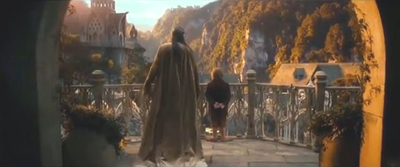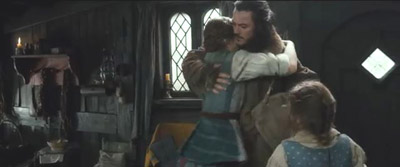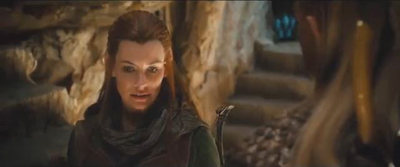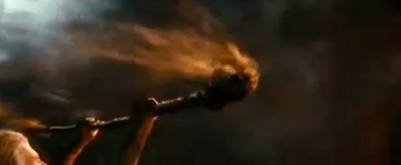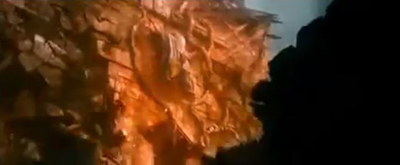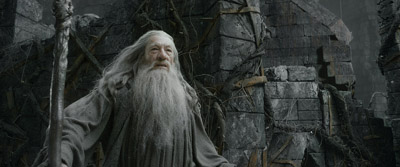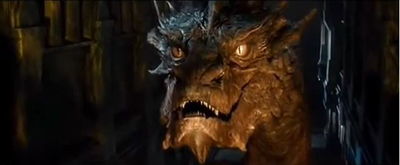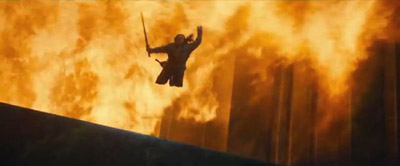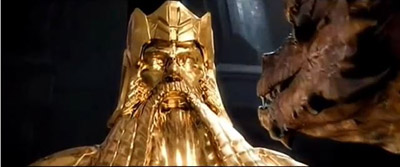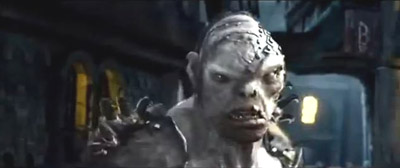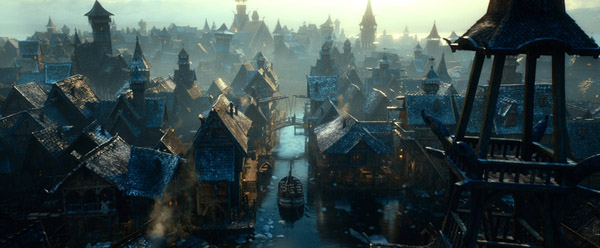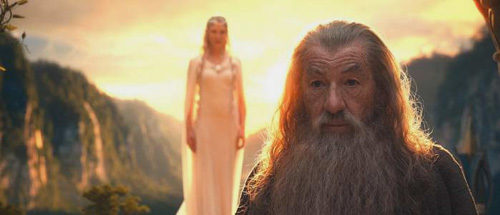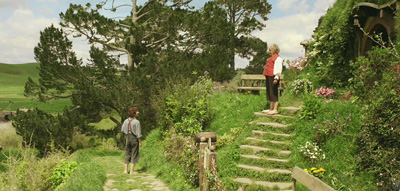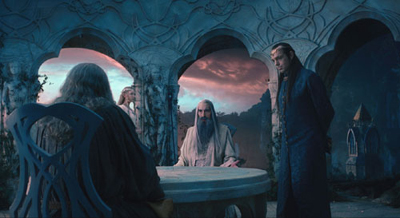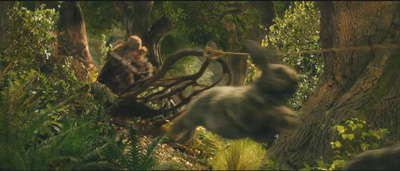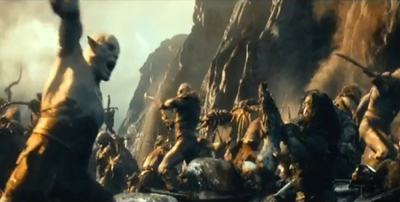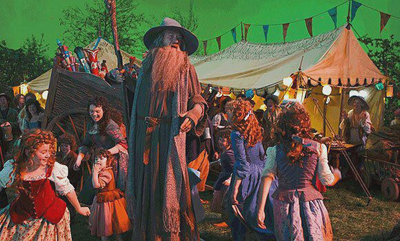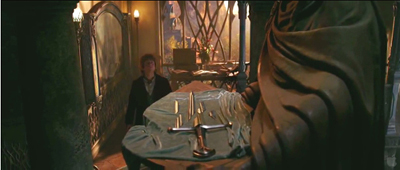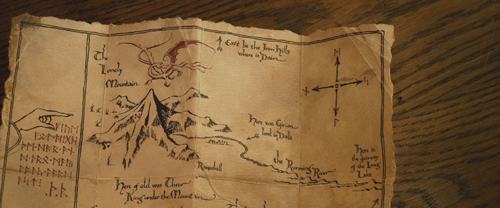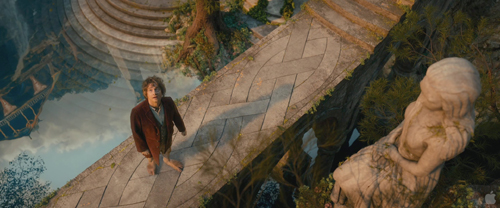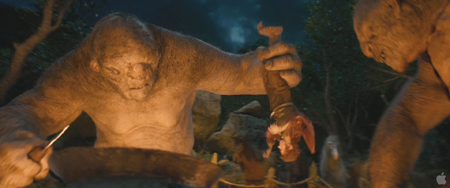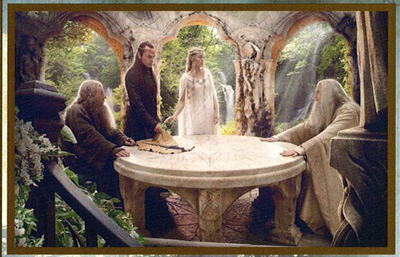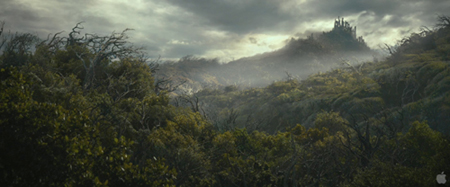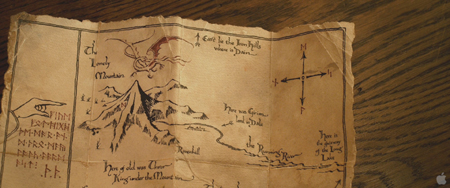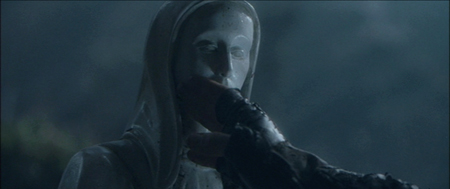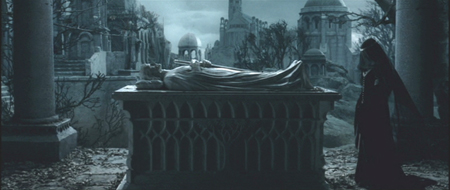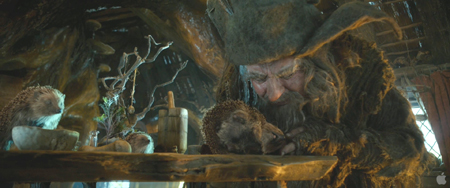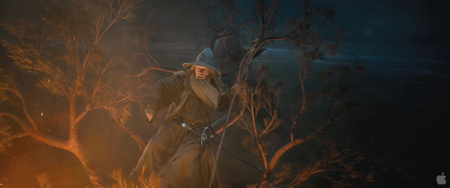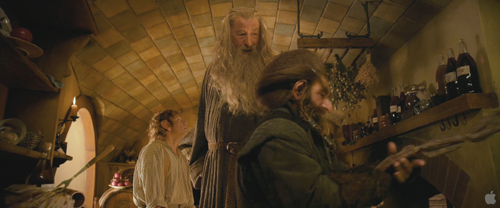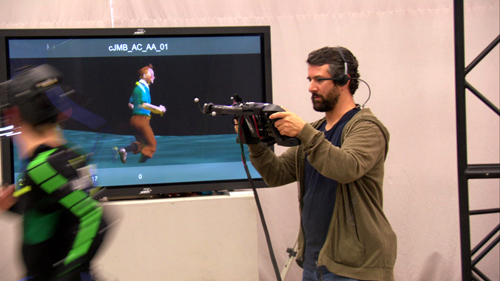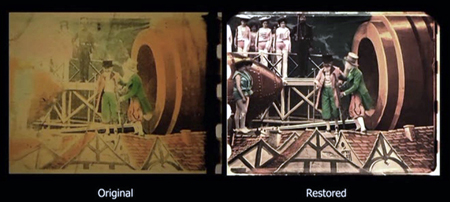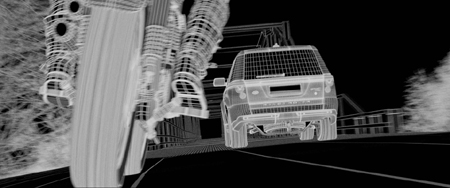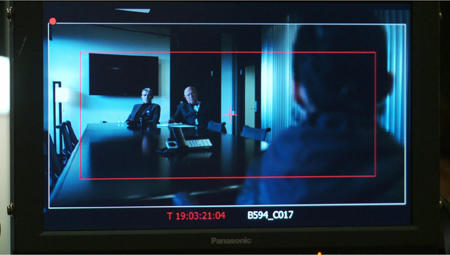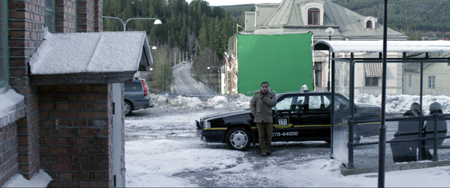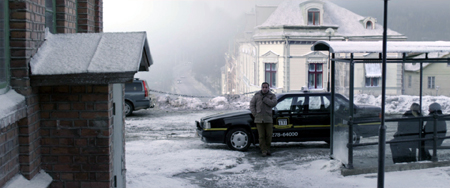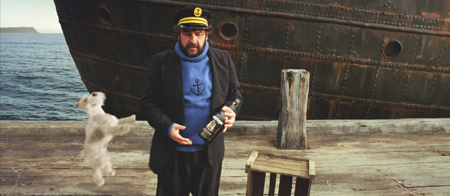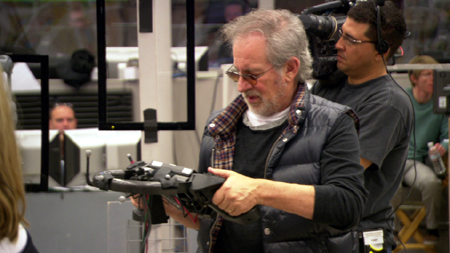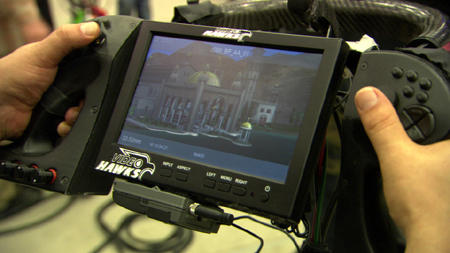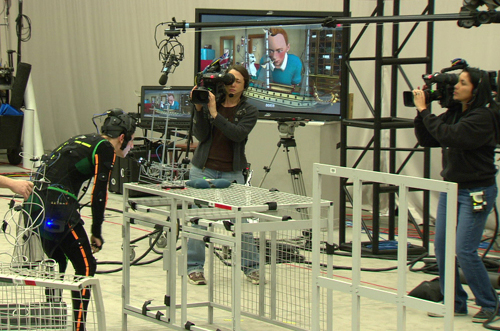Archive for the 'Directors: Jackson' Category
Is Tauriel more powerful than Eowyn? and other questions we shouldn’t have to ask
Kristin here:
Film franchises now make up a significant portion of Hollywood’s output, and that situation that is likely to linger, at least until we see even more blockbuster flops than in 2013. Prequels are one way of extending a franchise. They’re a risky proposition, though. These days, who ever thinks about Butch and Sundance: The Early Days or Hannibal Rising? How many would defend the idea that the second Star Wars trilogy (now Episodes I, II, and III) are equal to or better than the first (now Episodes IV, V, and VI)?
Quite often the original entry is an adaptation of an existing work, and there is no additional source material for a prequel. The filmmakers have to make up the story, and the risk is that the prequel will end up being an imitation of the original or take the premises of the original too far. This is especially true of literary properties, even if the original author pens the prequel, as Thomas Harris did with Hannibal Rising.
Peter Jackson and company would seem to have been in the ideal situation. They adapted a beloved literary classic, The Lord of the Rings, and it became a popular and critical success. There was already a potential prequel in the form of a second classic by the same author, J. R. R. Tolkien. Of course, The Hobbit was published first, and The Lord of the Rings was a sequel to it. Through sheer chance, however, the fact that the distribution rights for The Hobbit had not been sold along with the other film rights to the two novels, the filmmakers were not able to begin with it. Only after LOTR was out did MGM, owner of those distribution rights, come on board as co-producer, and the film Hobbit became a prequel.
Now Jackson had a book written by the same author and access to considerable material in Tolkien’s appendices. He was working with a team consisting of many of the same writers, designers, and technical experts. They were in a strong position to create a film that had the same look and feel as LOTR. With the added material, the dramatic weight and the length of The Hobbit could balance that of the LOTR trilogy. The two stories could blend seamlessly. Possibly more seamlessly than the original novels, which had some gaps and inconsistencies arising from the fact that The Hobbit was a children’s story published in 1937 and The Lord of the Rings was a longer, more serious novel that came out nearly twenty years later.
Now that The Hobbit: The Desolation of Smaug, the second of three parts of The Hobbit, has been released, perhaps it’s time to check in on how the filmmakers are maintaining it as a lead-in to their LOTR trilogy. Unfortunately, I think some serious problems have arisen that were not present in the The Hobbit: An Unexpected Journey. Some of these problems arise from departures from the novel that don’t make sense in relation to the original trilogy; some arise from unclear or unmotivated actions invented by the screenwriters; and worst of all, some result from new characters and situations that too closely resemble those in the original trilogy. Whatever is added to the extended version of Desolation and whatever happens in the third part, There and Back Again, the prequel is now flawed.
The Extended Edition of An Unexpected Journey
But first, some unfinished business concerning the first part of the prequel. Almost exactly a year ago, I posted an entry on the theatrical version of Journey. Having already pointed out that there was plenty of material in the Lord of the Rings appendices to extend the two-part Hobbit adaptation to three parts, I defended certain additions to the plot. These were notably the White Council scene at Rivendell and the inclusion of Radagast the Brown, a wizard only referred to in J. R. R. Tolkien’s novel (though he does appear briefly in LOTR). After all, the appendices are really for both The Hobbit and The Lord of the Rings, containing additional material for each of the novels.
I was far less keen on the Azog the Defiler plotline, entirely invented by the filmmakers. Yes, there is a scene in the appendices where Azog briefly appears in the battle at Moria, but he dies in that battle. The notion of him chasing down Thorin from motives of revenge is wholly new. I argued that the Azog-related scenes overburdened Journey with extra action that disturbed the balance of the narrative, adding an unnecessary battle at the end that came too soon after what should have been the highlight and climax of the film, the underground escape from the goblins and the Riddles in the Dark scene.
I speculated at the time that some specific scenes eliminated to make room for Azog would be added to the extended edition, perhaps helping to redress the imbalance. Were they, and did they?
The main scenes that I anticipated did get added to the extended-edition DVD/Blu-ray release. I think almost everything added to it is a plus. Most of the new scenes are quiet ones of exposition and characterization rather than frantic action, which the later portions of Journey were sadly lacking. Yet this doesn’t help much to balance the narrative any better, since most of the added bits come in the first half of the film, the half that was already quieter and less jammed with action than the later portions. Still, given how much violent action there is late in the film, any quiet action helps counter it to some degree.
As seemed very likely, early on there is a flashback to Gandalf setting off fireworks at a Hobbit party where he meets young Bilbo for the first time. It’s charming and all too short, zipping by, but at least we see a rambunctious young hobbit very different from the staid, middle-aged Bilbo of Bag End. The contrast helps motivate Gandalf’s disappointment in the adult Bilbo and his remarks about how he has changed. The moment also helps motivate the notion that there is a suppressed Took side to Bilbo’s nature, just waiting to be summoned forth by a pushy wizard.
Another extra early scene shows Bilbo, nervous after the visit from Gandalf, shopping for the ingredients for his supper (including the fish later consumed so thoroughly by Dwalin). The brief scene doesn’t add much to the plot, but it serves to introduce the Shire and Hobbiton to those who may not have seen LOTR, and it provides some humor after the tense ending to the initial conversation with Gandalf.
As I anticipated, the Rivendell interlude is expanded. In fact, the bulk of the new and extended scenes occur here. Bilbo wanders around Rivendell, clearly overwhelmed by its beauty. He not only sees the shards of Narsil but stares at the nearby mural of Isildur cutting the Ring from Sauron’s hand. Thus Bilbo sees the Ring shortly before he finds it himself, though there is no one present to tell him what he’s looking at. He also chats with Elrond, who says he is welcome to stay in Rivendell. He presumably means that Bilbo need not accompany the Dwarves when they continue on their journey, but a bit over sixty years later Bilbo will end up living there.
The extra comic bits with the Dwarves, including Bofur’s song, are perhaps entertaining enough, though they continue to film’s general tendency to make them overly boorish.
The White Council scene is extended mainly by Gandalf’s exposition about the Seven Rings of the Dwarves, which Saruman dismisses as irrelevant. The Seven Rings are not referred to in the theatrical version of The Desolation of Smaug, though presumably they were put into Journey for a reason and will return at some point, if only in future extended versions.
The scene with the Great Goblin is stretched out, as he is allowed to sing the Goblintown song from the original book. I think Barry Humphries was an inspired choice to provide the Great Goblin’s voice, so having a little more of him is welcome.
Luckily, there are no extra scenes involving the Azog plotline.
Caution: From here on there are major SPOILERS for the concluding part, The Hobbit: There and Back Again as well as for Desolation.
A better film–if you don’t think too much about it
The reaction to Desolation has been strangely split. On the whole, the critical establishment has heralded it as an improvement on Journey. No long setup of thirteen Dwarves and their quest–just a long series of exciting action scenes culminating in an extraordinary special-effects achievement with the dragon Smaug. The Dwarves’ escape from Thranduil’s realm in barrels rushing down a river with a running battle involving Orcs and Elves has been compared, in the usual reviewers’ cliché, to a thrilling theme-park ride. The battle with the large spiders has also been lauded.
Many fans of Peter Jackson’s other films in the series love Desolation as well and have been going to see it multiple times. Yet fans who know Tolkien’s books really well, while often enjoying the film, have been far more grudging and selective in their praise.
This is largely because Desolation departs far more radically from the novel than any of the previous four films have. New characters have been invented, most notably the female Elf Tauriel, and new scenes fabricated, as with Gandalf’s disastrous solo visit to Dol Guldur, where he ends up imprisoned, or the hectic string of suspense and action scenes at Lake-town. Thranduil briefly appears in the book, but his role as an enemy to the Dwarves has been expanded. The scene of the Dwarves entering Erebor and trying to kill Smaug with molten gold has no parallel in the book.
Inventing scenes needn’t be a problem. Many have complained about the made-up warg attack that ends in Aragorn’s apparent death in The Two Towers, but it is integrated fairly well into the plot. Departures from the original Hobbit novel may be annoying to some, but one should ask how well they fit into the cause-and-effect flow of the plot and into the film as a whole. More specifically, the filmmakers were trying to make The Hobbit into a more substantial film than simply following the book would have allowed. They had to do so in order to blend smoothly into the same world as the LOTR film. The question, then, is really whether the changes 1) are logical in themselves and in relation to the other trilogy, and 2) are an improvement on what the filmmakers could have accomplished had they stuck closer to the story.
Unfortunately, I think that in many cases the new and extended characters and scenes are not as strong as they could have been. More problematically, certain choices steal inspiration from the LOTR film trilogy and in the process undermine the dramatic impact of some of its scenes. This would seem to be something to avoid at all costs in creating a prequel: making the original seem less fresh and dramatic.
Back when I wrote about the decision to split The Hobbit into three parts, I defended Jackson from the accusation that he was clinging to this franchise because he had lost some of his inspiration and didn’t know where to go once the Tolkien adaptations were finished. I don’t know whether it’s true that such a lack of inspiration led to Jackson’s choice to direct the film that he originally wanted to assign to someone else. My point was simply that there was enough material in the novel and in the appendices to expand the film to three parts, if the screenwriters took advantage of that material and fitted it into the plot skillfully. The addition of the White Council/Dol Guldur plot line, largely based on brief statements in the appendices, suggested that Journey was following that path. I don’t think Desolation continues that pattern of relying on snippets from the original books–and there are some that go unused–to flesh out into new story material. This change is to its detriment.
There have been some thoughtful essays suggesting that the film falls down in its invented portions. Timothy R. Furnish, a long-time columnist for TheOneRing.net, has contributed an essay criticizing the main changes from the book. Furnish admits to being a purist, but his claims about the changes suggest that they do not benefit the film. For example, he points out that the plot line involving Gandalf’s and Radagast’s visit to investigate the tombs of the Nazgûl is “rather confusing” and “seems forced and, frankly, unnecessary.” I don’t completely understand that plot line myself, given that it’s not in Tolkien and not explained very well in the film. Elrond said at the White Council meeting that the spells holding the Nazgûl in their tombs were unbreakable. So far there’s no explanation as to how they escaped. Are most viewers able to connect those empty tombs to the Black Riders we had first met early in Fellowship? I doubt it.
The inclusion of this tangential plot line also means that Gandalf is lured away from his commitment to the Dwarves’ quest not once, but twice, which isn’t very effective dramatically. Galadriel goads Gandalf into investigating the tombs, and Radagast persuades him to explore Dol Guldur. Thus the two of them end up being responsible for his defeat by Sauron while themselves not offering much help. Gandalf also looks weak and indecisive, capable of being talked into an unwise course of action.
How could this have been handled better? Stick to the book. Tolkien never tells us what happened to the Nazgûl in the centuries immediately following Sauron’s defeat and Isildur’s taking of the Ring. It just doesn’t matter. Why drag it into the film? (Possibly extra material in the extended version will better explain this minor plot line, but I doubt there will be anything new relating to it.)
Furnish points out something that has been universally criticized among fans of the books. The episode at the home of Beorn, the large man who can change into a bear, has been so truncated as to be rendered almost pointless. Sure, the design of his house is nice, but why bother? Yes, it offers a brief refuge from the pursuit by Azog’s band–but that just raises the unanswered question as to how Azog found them again after they had been carried so very far by the eagles. The filmmakers needed to include Beorn, since he should return to play a major role in the third part. At least his presence strongly hints that they haven’t eliminated him from that major role. Jackson has assured fans that there will be “a couple more scenes in the extended cut of this film, and some more of him, which I won’t be describing, in the third movie!”
A better approach? In the book, the company have lost all their ponies and supplies in the goblin-caves adventure and are in need of rest and assistance, not rescuing from Orcs. They stay with Beorn for a few days. He’s a fascinating figure in the book, with his giant bees and animal servants. He’s also not the defeatist, lonely figure of the film but a pugnacious guardian who keeps a small region east of the Anduin River free of goblins and wargs. Presumably the extended edition will at least give him a little more screen time. This could have been a chance to add some of the charm and humor of the book to a film that sorely lacks them, in its second installment at least.
As Furnish writes, Bard is a “grim-voiced and grim-faced” leaders of Lake-town’s archers in the book, not a ferryman and smuggler with children to feed. Yet, as Furnish says, “making Bard less of a recalcitrant loner is defensible.” I’d say more than defensible. It may be the only major change that improves on Tolkien, at least in one way. Tolkien’s decision to have Smaug killed by a very minor character was probably a mistake, and fleshing Bard out into a significant figure works reasonably well–though it also is encumbered by the whole conceit that the Dwarves and Bilbo have to be smuggled into Lake-town and that Bard is at odds with the Master of Lake-town and his assistant Alfrid (the latter an invention of the filmmakers). In the book, the Dwarves are welcomed to the town from the start, as potential slayers of the dragon and sources of future prosperity. The chapter about Lake-town is titled “A Warm Welcome.”
Furnish also makes a more general point: that both parts of The Hobbit far are short on sympathetic characters. LOTR is full of heroes–and even Boromir, after trying to take the Ring from Frodo late in Fellowship, redeems himself by trying to save Merry and Pippin. But in Jackson’s Hobbit, few of the characters beyond Gandalf, Bilbo, a few of the Dwarves, and Tauriel are particularly admirable. Dwalin, ever suspicious, even suggests killing Bard and taking his boat. Not nice.
Whether or not audiences perceive the characters as Furnish suggests, there is no doubt that LOTR involves characters fighting for the common good and making considerable sacrifices to do so, while most of The Hobbit‘s characters are in contention over the wealth they would gain if Smaug can be killed. There’s also a prominent revenge motif. (Again, Gandalf, Bilbo, Galadriel, and Elrond excepted, and the latter two essentially don’t appear in Desolation.) The Dwarves are a greedy bunch in Tolkien’s novel as well, but The Hobbit is a more comic, more conventional fairy tale than is LOTR, and besides, none of his Dwarves ever behave as callously or as crudely as the film versions do.
This problem of unpleasant characters is particularly noticeable with Legolas. He has been made so intolerant, so offensive, and so callous that many fans would rather he had been left out altogether. Certainly the Tauriel-Kili romance could have worked without him. Perhaps he will improve a bit by the end of the third part, but he is far from the sympathetic Elf that became the idol of fangirls in LOTR. He even looks different, as if Orlando Bloom’s entire face has been Botoxed and too light a shade of blue has been used for his contacts. Here’s a case where purely financial considerations may have played a prominent role in the decision to insert him into The Hobbit.
How could all this have been avoided? In part by trying to achieve something of the sense of fellowship that made LOTR so appealing. Avoid overloading the film with characters who act through motives of revenge and distrust. The invention of the Orc-pursuit subplot is largely to blame for this, as is the caricatured depiction of the Master of Lake-town. The focus should really be on Thorin’s growing obsession with the Dwarves’ lost treasure, which eventually will lead to his break with Bilbo, despite all the latter’s heroic rescues. That obsession is brought up a few times, but it’s obscured by the general emphasis on revenge and greed.
Once more on the issue of padding
Another insightful piece, written by Michael Martinez, takes on the question as to whether Desolation‘s story has been padded out. He points out that in fact a great deal has been cut out of the book, trimming what was already supposedly too short to form the basis for two or three lengthy films. As Martinez writes, the crossing of Mirkwood has been compressed from weeks into what apparently are two or three days. The passage where they wander, dazed, in the woods is the only point at which much time can have passed, and we’re given no sense of how long they are lost before Bilbo climbs the tree–a moment that at least keeps the book’s scene of him delighting at the butterflies he encounters. In the novel, there are other adventures in the woods, and the Dwarves apparently spend about two weeks locked in their cells in Thranduil’s realm, during which time Bilbo, wearing the Ring explores the caverns and finally figures out a way to free them.
The filmmakers then add all sort of things that are not in the book. Is this new material, Martinez asks, padding? He seems not to think so, but I’m not so sure. If the new material is, like the whole Azog subplot, unnecessary and even detrimental to the balance of the narrative, doesn’t it count as padding–especially since it crowds out such things as a more satisfying episode involving Beorn?
Take whole running battle as the Orcs chase the fleeing Dwarves in their barrels down the river and the Elves chase the Orcs. (In the book, the barrels are sent down the chute into the river and simply drift downstream until some Elves steer them along to Lake-town, which is on the near side of the lake.) Yes, the river escape and battle are exciting and fun to watch, if overlong, but they point up yet another problem of balance in this and other action scenes. The barrels chase make the Orcs look remarkably ineffectual. Tauriel and Legolas pick them off at a great rate, both in this scene and in the Lake-town skirmishes. In the river scene, the Orcs do manage to kill some anonymous Elven guards at the sluice gate, and they wound Kili, but they ultimately create more delays than damage and eventually lose their quarry. Such efficient killing of Orcs happens to some extent in Journey as well, but as the Dwarves’ bowman Kili does not have the athletic virtuosity of Legolas and Tauriel, the cannon-fodder nature of the Orcs is less obvious. By the end of Desolation, though, can we really take them that seriously?
The messiness of the Azog/Bolg revenge plot line culminates (at least for now) in the Lake-town scenes, with sinister forces multiplying to a confusing extent. As Martinez puts it, “But with Orcs, elves, dwarves, and the Master’s spies all sneaking around Lake-town I really felt like we had left The Hobbit behind and entered the world of ‘Dungeons and Dragons’ or something.” New or not, I would say that such antics constitute padding, in this case via Jackson’s penchant for extending and multiplying dangers and fights.
Certainly all these invented characters and scenes aren’t necessary because there really turns out not to be enough material in The Hobbit and the LOTR appendices to make up three parts. One puzzling aspect of Desolation is that it fails to pick up plot lines the filmmakers themselves had set up in Journey. The latter, despite its awkward concentration of slower sequences early on and rampant, almost continuous fighting in the second half, had established a pretty good set of plot lines (excepting the superfluous Azog one). They’ve all but disappeared.
I speculated in my entry on Journey that we might discover in part 2 that Saruman was already corrupted by desire for the Ring and wants to prevent an attack on Dol Guldur because he’s already looking for the lost Ring himself. That would have been interesting and true to the information in the appendices. Instead, Saruman doesn’t appear in Desolation. Was bringing Saruman into The Hobbit (where he doesn’t appear, given that Tolkien didn’t invent him until well into the drafting of LOTR) just a little salute to a popular actor? Or will he return in the third part to take part in the attack on Dol Guldur? In which case, will he actually be helping the other White Council members, or doing something devious? (In the appendices, we learn that he did help, mainly to get Sauron away from the area near Dol Guldur where the Ring slipped off Isildur’s finger and sank to the bottom of the Anduin; Saruman himself has been searching the river.) The filmmakers created Saruman’s scenes in The Two Towers so skillfully that his absence here is disappointing. If he is going to reappear in the concluding part, it would seem a good idea to at least mention him. If he isn’t, some way of motivating his absence would have been helpful.
Similarly Radagast, whose insertion into the first film I defended, is barely in this one. He doesn’t do much when he is present, either, mainly pressing Gandalf to investigate Dol Guldur and then, once they reach it, going off to take a message from Gandalf to Galadriel. Will Radagast play a significant role in the final part? One would think so, but at this point I’m not betting on it.
That reminds me
Most crucially, I think, instead of using these already established characters in Desolation or just sticking more closely to the book, the filmmakers have introduced many new elements that are essentially diminished versions of characters and events in LOTR. That strikes me as a bad idea and perhaps really does betray a lack of inspiration. Already fans of the LOTR films have complained that so many echoes of LOTR appear in Desolation. Worse is to come, though. When people view LOTR as part of a series of six parts beginning with The Hobbit, they will end up seeing things in LOTR as echoes of Desolation. The result will be to rob LOTR of some of its originality and effectiveness.
Take Tauriel. She’s a pleasant, admirable character, with a stubborn, headstrong streak that keeps her from being bland. Evangeline Lilly’s performance strikes me as excellent. A lot of fans worried about her inclusion in the film but came to like her. They seem to see her as blending well into the world of the film. But there’s a reason for that. She does come from the world of LOTR.
Was it really a good idea to add a major character who’s basically a blend of Arwen and Eowyn? Doesn’t she make both of those characters less distinctive?
If a lowly Sylvan Elf like Tauriel can rescue Kili from a giant spider and later use the herb athelas (“Kingsfoil”) to heal his wound, are LOTR’s similar rescues of Frodo by Aragorn, Arwen, and even Sam not rendered a bit less impressive? (In the book, Bilbo does all the saving of the Dwarves from the spiders; no Elves appear.) Later, the arrow that strikes Kili is referred to as a “Morgul” weapon that will kill him. Thus it resemble Frodo’s wounding by a Morgul blade by the Witch King at Weathertop in Fellowship. Again, Frodo’s wounding, which seems unique and bound up with the Ring’s evil influence, is cheapened. How can just any random Orc be carrying a weapon with a Morgul spell on it, something we were led to think is unique to the Nazgûl (and in the book, such weapons are). In Bard’s house, Kili’s vision of Tauriel surrounded by glowing light recalls Frodo’s vision of Arwen when she approaches him in Fellowship. Arwen’s stature is lessened by the suggestion that all Elven women can appear this way to mortals. (There’s a reason why Thrandruil doesn’t want his son to fall for Tauriel, though I’m sure he would be thrilled were Arwen to agree to marry Legolas.)
With Tauriel’s limitless athleticism and fighting capabilities, won’t she steal some of the thunder from one of the LOTR film’s most beloved characters, Eowyn? Across Tolkien’s two novels, Eowyn as a female warrior of Rohan was unique. She was unique in the films, too, until now, when Tauriel popped up to dispatch dozens of Orcs with the same aplomb that Legolas does. Did the writers never consider this problem? Was there no other way of creating a “strong” female character besides making her a fighter?
For that matter, why not do something more with the strong female character they already have, Galadriel? Why does she send Gandalf off alone to do the dirty work of investigating the tombs and Dol Guldur? After the White Council scene Galadriel assures Gandalf that she’ll come and help him if need be. Why not just give him a hand to begin with and not wait until Gandalf nearly gets himself killed. In the book Galadriel is ultimately the one who destroys Dol Guldur at the same time the Fellowship and other characters are down south attacking the Black Gate and destroying the Ring. It’s not as though she’s a shrinking violet.
Beyond being the strong female, Tauriel is also there partly to create the love triangle between her, Legolas, and Kili. That romance, though, is sketched out in terribly conventional terms. Tauriel’s interest in Kili is expressed through her remark that he’s tall for a Dwarf, and the final moments between them after she has healed his wound turn distinctly maudlin, with him failing to recognize her and asking weakly if she thinks Tauriel could have loved him.
One of the fans on the TORn Message Boards, ec1988, has started a thread called “The inclusion of Tauriel diminished Legolas.” There simplyaven argues that the Tauriel-Kili romance to some extent presages Legolas’ friendship with Gimli and undercuts its presentation in LOTR as an unusual, even unique overcoming of racial hatreds. That seems right. Her “Aren’t we part of this world?” also echoes Merry’s question to Treebeard when the Ents resist the idea of attacking Saruman. (This isn’t the only line repeated almost verbatim from LOTR.)
Another distinct echo of LOTR results from Gandalf’s fight with Sauron in Dol Guldur. It looks remarkably like his duel with Saruman in another tower, Orthanc, in Fellowship. Saruman takes Gandalf’s staff during that one, while Sauron seemingly dissolves Gandalf’s staff into dust:
This moment also echoes the scene in Return of the King where the Witch King knocks Gandalf the White off Shadowfax and dissolves his staff (in the extended edition only).
By now Gandalf has lost a number of staves across the five parts of the epic tale. It has become a sort of unintentional running joke on discussion sites as fans tot up how many staves Gandalf has lost and where he might be getting the replacements. Posts include photos to demonstrate the slight differences among them. One relatively brief example from the Message Boards on TORn comes from 2008–years before The Hobbit included at least one more destroyed staff. As moderator Ataahua remarked, “Back in the day, someone on TORN wondered if Gandalf had a locker of spare robes and staffs at Rivendell, as if it were a handy bus station. :)” Whether Radagast will give Gandalf his to replace the one destroyed by Sauron is a current topic of discussion.
But getting back to the Dol Guldur battle. Sauron slams Gandalf to the ground, then tosses him up so that he’s “velcroed” to the wall–pretty much as Saruman had done:
In Fellowship, Saruman imprisoned Gandalf on a tiny space at the top of Orthanc. Sauron suspends him in a small cage. I wonder if someone watching all six parts straight through might not find the Saruman-Gandalf battle a bit ludicrous because it is so similar to the “earlier” one. (To me, the wizard-duel was already somewhat ludicrous–and of course, it didn’t happen in the book.)
There are other signs of Desolation cannibalizing ideas from LOTR. The invented character of Alfrid, assistant to the Master of Lake-town, is a lot like Theoden’s slimy, treacherous adviser Grima. Thranduil is like Denethor in his refusal to consider the welfare of anyone beyond the boundaries of his own realm. Furnish calls the Master of Lake-town “the Goblin-King with a comb-over and more clothes,” suggesting a cannibalization from within The Hobbit as well.
Gandalf the Wimp
In this film, the writers don’t seem to know what to do with Gandalf. Midway through the book, he simply leaves the Dwarves and Bilbo at the edge of Mirkwood to take care of “some pressing business away south”–as he had planned from the start to do, so there he isn’t suddenly abandoning them. He returns in time to participate in the Battle of Five Armies, near the end of the novel.
Tolkien was smart enough to know that Gandalf was simply too powerful to keep around all the time. Where’s the suspense if you’ve got a wizard along to solve problems like capture by trolls or goblins? So he invented various devices to take him away from the action for stretches of time. (These became more complicated in LOTR; I devote part of a chapter of my book-in-progress to these tactics.) Only near the end of The Hobbit novel do we learn that Gandalf and the White Council have driven the Necromancer out of Dol Guldur. Indeed, Tolkien invented the “Necromancer” simply as an excuse to leave Bilbo and the Dwarves alone, forced to defend themselves. It was only by happy accident that this sinister figure, barely mentioned in the novel, was available to become the source of LOTR’s supreme villain.
So why doesn’t Desolation have Gandalf go off to do his “pressing business” and then concentrate instead on Mirkwood, Thranduil’s imprisonment of the Dwarves, the trip by barrel to Lake-town, and above all on Bilbo’s maturation? I have to believe it’s because Ian McKellen is arguably the biggest star involved in these films. True, others have also become famous as a result of appearing in The Hobbit, but back when the film was being written and shot, Ian was central. In the credits his name appears before that of Martin Freeman.
The problem confronting the filmmakers was that Gandalf is a supporting character in The Hobbit, albeit a major one. (I would argue that he and Frodo are the two protagonists of LOTR, the novel.) It would be appropriate for him to be absent for most of the second half of Desolation, but clearly the filmmakers felt they couldn’t afford to give up their top star for so long. Hence they invented scenes to give him something to do. The obscure mission to the tombs in the High Fells is one such scene. In terms of the plot as a whole, however, it could easily be done without.
More crucial, though, is Gandalf’s invasion of Dol Guldur, his challenge to the hidden forces there, and his losing battle with the Necromancer, now revealed as Sauron. The fact that he ends up helpless and in need of rescue raises yet another question: Why does he do such an idiotic thing? No reason is provided. He is certain that he’s going into a trap, and he has no idea what’s waiting inside for him. What could he possibly hope to accomplish? (If he were going in to try and rescue someone held prisoner inside, that would be another matter.) I think we’re to take it as a brave move on his part, and he does manage to hold his own against Sauron for a short time. But basically it’s a huge mistake on the part of a wizard we’re supposed to consider wise.
The sensible thing for Gandalf to do would be to go and alert Galadriel, who presumably has returned to her home in Lothlorien. That realm is situated relatively close to Dol Guldur, almost directly across the Anduin. Gandalf and Galadriel could summon the White Council and gather Elvish troops to lead an attack on the tower. In the book, that’s what Gandalf’s “pressing business to the south” is.
In general the Gandalf of the films is a far weaker, more vulnerable figure than the one in the books. I cannot imagine the Gandalf of the books would say that he’s afraid and that having Bilbo along on the quest gives him courage, or that he would need such reassurance and guidance from Galadriel. The Witch King could hardly knock him off his horse. In Fellowship (the book) Gandalf manages to hold off the nine Black Riders all night when they attack him on Weathertop. He doesn’t kill any of them, but he manages to escape unscathed.
Moreover, in the book Gandalf has been to Dol Guldur twice before, long before the action of The Hobbit. The first time, nearly 900 years earlier, Sauron is hiding there, slowly regaining physical form. Tolkien’s summary of the event in Appendix B is terse: “Gandalf goes to Dol Guldur. Sauron retreats and hides in the East. The Watchful Peace begins. The Nazgûl remain quiet in Minas Morgul.” Later Gandalf sneaks into Dol Guldur to as a spy and discovers that Sauron has returned. He also finds Thrain, Thorin’s father, dying, and receives from him the key and map that he later gives to Thorin in Bag End. (One would think that a flashback to that scene would have been dramatic and suspenseful.)
Tolkien never tells us what Gandalf did to make Sauron retreat. Maybe just the wizard’s presence frightened him away. Similarly, how he managed to spy inside Dol Guldur remains unexplained. The point, though, is that the filmmakers have made Gandalf weaker primarily to generate even more suspense and violent action and to set up a rescue of the hapless wizard that will surely involve an attack on Dol Guldur in the final part. Never mind that Gandalf’s invasion of Sauron’s stronghold in Desolation makes no sense.
Gandalf isn’t the only one who is made less powerful and dangerous in order to generate a grand action set-piece. Even the villain of the title is made to look rather foolish.
Smaug the Clueless
There is no question that Smaug as a CGI creation is a marvel, and Benedict Cumberbatch provides his voice, as manipulated by the sound crew, very effectively. Throughout his initial scene with Bilbo, which sticks pretty closely to the book, he seems appropriately menacing, sly, and playful in the manner of a cat toying with its prey.
As soon as the Dwarves join Bilbo inside Erebor, however, Smaug is revealed to be strangely ineffectual.
Once the Dwarves decide on their strategy of flooding Samug with molten gold, they split up to take separate routes to the forges. Time and again they manage to elude the beast as he searches for them. At once point he passes right above Thorin’s group and fails to notice them. Wouldn’t Smaug be glancing in all directions as he moved? And so much for his vaunted sense of smell. At one point Thorin leaps into space to avoid a blast of fire (below) and manages to catch hold of a chain hanging conveniently in his trajectory. Smaug follows him, curling around the dangling Dwarf but makes no real attempt to kill him. At one point, Thorin even ends up standing astride the creature’s mouth for a few moments. Now that he has found Thorin, Smaug doesn’t do the obvious–open his mouth and take a bite of him. Later, when Thorin stands exposed on the giant mold full of molten gold, he and Smaug are face to face. The dragon, instead of incinerating him, trades insults. (Of course, movie villains often miss their chance to vanquish their foes, in a convention termed by Roger Ebert “The Fallacy of the Talking Killer.”)
There is so much in the sequence of the Dwarves’ attempt to kill Smaug that is distractingly implausible. Just as the lengthy falls in the Goblintown scene of Journey never seemed to cause so much as a broken bone, in Smaug’s domain the dragon breathes great sheets of fire repeatedly and never seems to singe the Dwarves. When Thorin’s jacket is set afire, he simply takes it off and keeps running.
How could this vast quantity of gold be melted so quickly? How could Thorin ride a river of molten gold in a metal wheelbarrow and survive? Why does the giant Dwarf king’s statue, when the mold is pulled away, stand for several seconds as Smaug admires it before suddenly gushing into a golden lake that momentarily overwhelms the dragon? And why, if Dwarves know so much about dragons, does it not occur to them that a creature full of fire couldn’t be killed in this fashion? Why would Smaug keep bashing down columns and other parts of the “building” which he considers his and where he plays to spend the rest of his life?
As with Gandalf, the filmmakers have robbed Smaug of much of his power in order to concoct a big action scene as a climactic lead-in to the cliffhanger. Admittedly, the shot of Smaug shaking off the coating of gold into tiny fragments is spectacular, and with that he regains something of his original menace. Yet the cliffhanger works mainly because we assume that the men, women, and children of Laketown, in their wooden houses, will be easier for the dragon to kill.
Mistakes, confusion, and omissions
There are a lot of unexplained, unmotivated things about Desolation. Some are relatively minor, such as how Smaug, who has been alone with his treasure ever since attacking Erebor, could know that Thorin had in the interval before returning gained the sobriquet “Oakenshield”? Or why does Lake-town, which seems to station guards and customs official at every possible entry into the city and spies everywhere, not keep a single guard on the broad, long bridge that links it to the shore?
As in parts of LOTR, there is some jiggery-pokery with time and space. Azog is summoned from a forest near Beorn’s house back to Dol Guldur, which he reaches during the same single night that the Thorin and company spend in the house. Gandalf remarks later that to go around Mirkwood would involve hiking 200 miles north and twice as far south (one fact that does come from the book). Dol Guldur is near the southern end of Mirkwood, so we are to believe that Azog’s warg is speedy enough to cover perhaps 350 miles in several hours. Of course, films play with compression of time quite frequently, but this case is very obvious, since there is an immediate return to the Dwarves’ group still at Beorn’s house.
There are other noticeable causal inconsistencies that make a greater difference in the plot. It was set up in The Two Towers that Galadriel and Elrond could communicate telepathically from a considerable distance. Galadriel and Gandalf speak mentally to each other in the White Council scene. Galadriel seemingly disappears instantly at the end of her talk with Gandalf after the White Council.
Now it turns out that Gandalf apparently can disappear, as he does during his battle with Azog, just before he meets Sauron. Why doesn’t he just stay invisible until he has escaped? Moreover, Galadriel speaks mentally to Gandalf from somewhere, presumably fairly far away. Yet he can’t speak to her that way and must send Radagast with a message to her.
What are the rules here? Why does Galadriel seem more powerful than Gandalf? Who are the wizards and how do they as a group relate to the Elves? The filmmakers could have dramatized a major passage in the appendices that explains who the wizards are, messengers sent by the “gods” of Arda to aid and advise the peoples of Middle-earth in their struggle against Sauron. Then we might be left with fewer crucial questions about these powerful figures, and some reliable premises could be established. LOTR does end with the subtle revelation that Gandalf, Galadriel, and Elrond have the Three Rings of the Elves. (Look quick or you’ll miss them.) The fact that Gandalf has one of the Three comes from that passage on the wizards that I just mentioned. Why ignore that passage, one of the precious few that do relate directly to the action of the White Council plot line?
Again, I think this happens partly because the filmmakers have adopted a tactic of weakening powerful figures like Gandalf and Smaug in order to generate more suspense and big action scenes.
There’s another decision that I think creates confusion. Yes, Azog, the character I dislike both in himself and for his revenge plot line’s unbalancing the film’s scenes, continues to intrude at intervals. As I had speculated, he turns out to be a minion of Sauron. There is still no explanation as to how Sauron could know that Thorin and company have set out from Hobbiton to Erebor and thus direct Azog as to where to hunt for him. For some reason, Bolg, another uber-Orc (above), shows up and summons Azog to Dol Guldur to consult with Sauron–presumably to help prepare his army for a big attack on … something. Then Azog sends Bolg off to take his place and continue the hunt for Thorin. Given that the two seem interchangeable, this whole replacement of Azog by Bolg makes little sense, except presumably to try and inject a little variety into the repetitious revenge plot. Little is the operative word.
One final point. In my previous entry, I mentioned that in Journey the filmmakers did a good job of planting links to LOTR: Saruman’s obstructionism, Galadriel as a powerful figure, Bilbo’s immediate love for Rivendell, the stone trolls seen in Fellowship, the frame story involving birthday-party preparations, and Bilbo’s wealth from the trolls’ hoard. Desolation has far less of this. There’s the picture of young Gimli that Legolas sneers at. There’s also Bilbo’s reaction to the corrupting power of his newly acquired Ring. I think his reaction is overdone. Only a short time after finding it, he seems at least as obsessed with it as we see him sixty years later, at the beginning of Fellowship. Good thing it’s a giant spider that he thinks is trying to take it from him, not one of the Dwarves. Shades of Smeagol! Apart from those added elements, there is little attempt to stitch Desolation a little closer together with LOTR.
Despite everything I’ve laid out here, I enjoy much of Desolation, and it has many good things in it. As usual, the sets, costumes, makeup, and all technical elements have been achieved with the utmost care and imagination. Quite apart from the complex movements of Smaug, with his long body and tail looping through the enclosed spaces of Erebor, there is much to admire. The big action sequences are quite fun. The acting continues to be excellent in most cases, particularly Martin Freeman as Bilbo. Although the hobbit no longer seems the center of his own story, Freeman manages to make every scene he is in a delight and to capture something of the feeling of the book.
Taken as an autonomous film, and despite its lapses in motivation and logic, it offers considerable entertainment and enjoyment. But as the second part of a series, it has gone off the rails, much as the Dwarves lose the Elvish path in Mirkwood. I suspect it will turn out to be the weakest of the six parts. At this point there is little if anything to be done to remedy this. (I cannot imagine that the extended version of Desolation will ameliorate the problems much, though I hope it will do so a little.) We are stuck with Tauriel, Bolg, and a weakened Gandalf for the third film. Still, I hope that There and Back Again will steer more directly toward links to LOTR. We shall see the Battle of Five Armies, and Jackson is nothing if not adept at big battle scenes.
What we can take away about prequels here is simply that filmmakers must not only make an original film in itself but must take utmost care to make it serve the franchise as a whole. Through the insistence that there must be a strong female character no matter what or Jackson’s frequently expressed justification that he added something simply because it would be fun, The Hobbit no longer fits well with The Lord of the Rings. That’s a pity, because up to now the filmmakers had been doing so well.
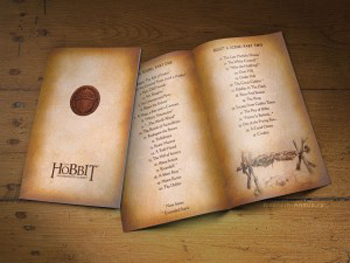 Purchasers of the extended version of AUJ will note that the packaging is not quite as impressive as that for the LOTR EEs. There is no booklet with John Howe and Alan Lee illustrations, nor one of the very helpful indices indicating which chapters are new or expanded and offering a map through the supplements. Fortunately a dedicated Russian fan, TheHutt (editor of the website Henneth Annun), has created one (left), with a remarkably accurate simulation of the design and contents of the LOTR booklets. The pages can be downloaded here. (Scroll down for the English-language version.) Kudos to him!
Purchasers of the extended version of AUJ will note that the packaging is not quite as impressive as that for the LOTR EEs. There is no booklet with John Howe and Alan Lee illustrations, nor one of the very helpful indices indicating which chapters are new or expanded and offering a map through the supplements. Fortunately a dedicated Russian fan, TheHutt (editor of the website Henneth Annun), has created one (left), with a remarkably accurate simulation of the design and contents of the LOTR booklets. The pages can be downloaded here. (Scroll down for the English-language version.) Kudos to him!
For those interested in the saga of Gandalf’s loss of staves. The Dol Guldur duel is chronologically the first time Gandalf loses a staff. Saruman takes the next one in Fellowship. The replacement is lost when Gandalf strikes the Bridge of Khazad-dûm with it, and bridge and staff both shatter. In his new incarnation revealed in Towers, Gandalf gets a white staff, which is destroyed by the Witch King in Return (extended edition). He has a duplicate of it in the Grey Havens scene at the end. Five staves–four of them destroyed–and counting. In the book the only loss of a staff comes at the breaking of the Bridge.
A hobbit is chubby, but is he off-balance?
Kristin here–
I first read J. R. R. Tolkien’s work during what might be described as the second generation’s discovery of The Hobbit and The Lord of the Rings. The Hobbit was very popular from its initial publication in 1937, enough so that the publisher asked for a sequel. Though Tolkien wanted LOTR to come out in a single volume, postwar austerity dictated that it be divided into three separate volumes. After their publication in 1954-55, a devoted following grew. The real explosion, however, came in 1965, when the Ballantine paperback editions appeared in the USA.
I was fifteen at the time and already an aficionado of Victorian literature (H. Rider Haggard, Jules Verne, Arthur Conan Doyle). I was used to reading long books (David Copperfield, Don Quixote). Like so many other people who were in high school or college in the 1960s, I loved Tolkien from the start. Eventually I became an academic writer. At some point, I decided to write a book on the two Hobbit novels.
I had done a lot of reading and note-taking for that project by the time of the release of Peter Jackson’s film version, The Lord of the Rings: The Fellowship of the Ring. With reservations, I liked that film. What fascinated me more, though, was the incredible success of the innovative marketing and merchandising side of the LOTR franchise. I decided this film was going to be historically significant in a major way. In 2002, I decided to write a book about it.
The Tolkien study was put way back behind even the back burner. The franchise book needed to be written now, when I could (I hoped) get access to the filmmakers and to information that would not be available after the last part was released. With enormous good luck and help from many interviewees, I managed to write The Frodo Franchise (2007). My Tolkien project came forward onto the stove and is now in progress.
I’ve kept up my interest in the films, though. Editors have asked me to write short pieces on Jackson’s LOTR, and I’ve done four of those so far. I maintained my Frodo Franchise blog until it became apparent that I would not be granted access to the filmmakers for a book on The Hobbit. Now I’m on the staff of TheOneRing.net, for which I write occasionally. Naturally I’ve kept up on the progress of Jackson’s new trilogy.
Not long ago in these pages, I wrote about the fact that The Hobbit had been expanded from its originally announced two parts to a three-part film. To those who accused the filmmakers of doing this for strictly mercenary purposes, I countered that there were reasons why such an expansion could work well. Mainly these relate to the extra material in the appendices of The Lord of the Rings, which provide information on two kinds of events: those taking place during the time period when The Hobbit’s action unfolds (most importantly an attack on Sauron’s [aka the Necromancer] lesser dark tower Dol Guldur) and those which took place in the past but which relate to characters and actions in the novel (e.g., Smaug’s attack on Erebor and Dale, the Dwarves Pyrrhic victory over the troops of the Orc Azog at Moria).
Having now seen The Hobbit three times, I want to suggest how successfully, if at all, the filmmakers have incorporated this material. For the most part the non-Hobbit material has been brought in well, or in some cases acceptably.
It’s a prequel now
One objection to the division of The Hobbit into three parts is that the book won’t support a narrative nearly as long as that of the filmed LOTR. Over and over, fans and critics have complained that Peter Jackson’s adaptation of The Hobbit (1937) isn’t designed as Tolkien wrote it, as a children’s story, lighter in tone and shorter than LOTR. They often also object to those who refer to it as a “prequel.” The novel’s events took place years before those of LOTR. It was also published first, appearing in 1937, while LOTR came out in three volumes published in 1954-55. The implication is that Jackson should just have ignored the other film and stuck strictly to the novel, which is about a quarter the length of the LOTR tome. As literature, LOTR is a sequel to The Hobbit.
But the films are different. Even if The Hobbit were adapted page by page, speech by speech exactly as written, those of us who have seen the LOTR film or read the book could not see it as a separate tale. We know already what the Ring is and what eventually happened to it, while readers, if they started with The Hobbit, do not. We know that Elrond is a powerful leader among other powerful Elf leaders, destined eventually to leave Middle-earth for the Undying Lands. We know Gandalf is a wizard who will guide the various peoples through the War of the Ring. And so on. Only viewers who see The Hobbit without having seen LOTR first or having read the book or having read any of the extensive media coverage of both could come to the prequel unaware of such things. And while the novel The Hobbit is not a prequel, the film adaptation certainly is.
Because most of us do know about these major characters and premises, Jackson and his team could hardly avoid trying to make the new film match his version of LOTR. He had to treat events, characters, tone, and setting with some consistency, and he had to link the films as one long account of historical events in the same era of Middle-earth.
Tolkien himself tried to smooth out the disparities between The Hobbit and LOTR, both in tone and causal connections. He revised The Hobbit slightly in 1947, mainly to make the Riddles in the Dark scene work better in the light of what the Ring eventually became when he brought it back as a more crucial plot element in LOTR. In 1951, those revisions got into the second edition of The Hobbit and have remained canonical ever since. In 1960 Tolkien was again disturbed by the differences between the two books and launched into a more thoroughgoing revision of The Hobbit to make it conform exactly to the later events in LOTR. Others convinced him that this was a mistake and that it damaged the charm of the earlier book, already a classic of children’s literature. Eventually he allowed those disparities to remain. He did, however, write passages in the appendices that at least briefly described events that helped stitch the two books’ narratives together.
I don’t see that it’s a problem for the filmmakers to use those passages to try and make their films flow more smoothly from the first to the second. In a few years we will be able to watch all six parts of what will then essentially be a single narrative with a sixty-year gap in the middle. For better or worse, depending on one’s opinion, this is Jackson’s Hobbit. Unlike Tolkien, he is making it after already having made LOTR. He can include the links between the two tales, as well as extra plot material that Tolkien published in the 1950s but hadn’t conceived in the 1930s. The question is not whether those links and that material should have been included but whether they have been well handled.
In terms of the links, many of the ones in An Unexpected Journey seem effective. The notion of starting The Hobbit at a point just before Gandalf’s arrival for Bilbo’s 111th birthday party seems a good one: we see Frodo nailing up the “No Admittance” sign from the early LOTR scene and then heading off to read in the woods and await the wizard (above). There’s an immediate recognition factor. The younger Bilbo mentions Bree, a locale seen in LOTR, and he recalls Gandalf’s fireworks from his youth. A fireworks display also figures in Bilbo’s birthday party scene in LOTR. Bilbo’s initial awe upon arriving in Rivendell and his reluctance to leave it tie in with the fact that he goes to live there after leaving The Shire early in LOTR. Certainly the inclusion of Balin, made into a more prominent character than he is in the novel and played with considerable humor and charm by Ken Stott, should make the discovery of his tomb in LOTR a more meaningful and poignant scene. On the whole, the stitching together of the two films so far is quite accomplished, and I assume it will continue to be so through the other two parts.
But is it padded?
Most of these links between The Hobbit and LOTR are brief references or gestures, made in passing. They are not the reason that Jackson’s team decided, to considerable critical and fan uproar, to make The Hobbit in three parts rather than the originally announced two. In the earlier entry, I suggested that there was material in the appendices of LOTR that fills in information relevant to The Hobbit’s plot.
There’s the backstory of the Dwarves, involving two major events. Bilbo’s exposition at the beginning establishes their great kingdom within Erebor (the Lonely Mountain). Its king, Thror (Thorin Oakenshield’s grandfather), oversees the accumulation of a huge horde of gold and gems, and it attracts the dragon Smaug. Smaug’s destruction of the Dwarves’ home and the neighboring city of Men, Dale (portrayed briefly in a sort of Renaissance Italian style), leads to the Dwarves’ exile and hereditary king Thorin’s eventual decision to try and retake Erebor.
Second, there is the great battle fought between the Dwarves and Orcs at Moria, in which Thror is killed and Thorin earns the respect of his people by defeating the great Orc leader, Azog—chopping off his arm and leaving him, as Thorin wrongly assumes, to die.
All of this the film explains in flashbacks derived from the LOTR appendices, and this embedded material seems to me to come off well. In my opinion, most of the other scraps of text used as the inspiration for scenes not in the original Hobbit novel results in reasonably successful scenes—with one major exception, which I will deal with in the next section.
The most important extra plotline concerns the White Council (not so named in the first part of the film). Initially I speculated that the White Council scene would be a flashback to an early meeting. That’s not the case, since Gandalf meets with Elrond, Galadriel, and Saruman during the visit to Rivendell (above). In the novel, when Bilbo and Gandalf revisit Rivendell on their way back to The Shire, the Hobbit simply overhears Gandalf talking to Elrond: “It appeared that Gandalf had been to a great council of the white wizards, masters of lore and good magic; and that they had at last driven the Necromancer from his dark hold in the south of Mirkwood.”
Here, by the way, is an example of the sort of inconsistent plot points that Tolkien presumably hoped to eliminate when he struggled to revise The Hobbit in the early 1960s. By then he had written LOTR and given the Wizards their emblematic colors, so Saruman (and later Gandalf) was the only “White” wizard. The “Necromancer” would become Sauron; the “dark hold in the south of Mirkwood” gained a name, Dol Guldur. What Jackson and the other writers have done is to move that meeting of white wizards (which took place somewhere to the south, presumably either in Lothlórien and Orthanc) to Rivendell. That simplifies things.
Now the question remains, to what degree does the White Council hint that Saruman has already become treacherous? Is he dismissing Gandalf’s worries as exaggerated merely because he’s conservative and just doesn’t much respect the Grey Wizard, or is he secretly searching for the Ring himself (as Tolkien revealed in the appendices)? I hope these questions will be explored further in one or both of the upcoming parts.
Interestingly, Gandalf is already visibly frustrated by Saruman’s presence at Rivendell, and the two are at odds about the degree of danger evidenced at Dol Guldur. Saruman favors inaction, meaning that he opposes the Quest of Erebor. Gandalf sees all sorts of ramifications in the presence of the dragon and the odd goings-on at Dol Guldur. Obviously we know Gandalf is right, especially since Galadriel sides with him from the start. The explicit representation of this action within The Hobbit’s plot is, I think, off to an excellent start. I look forward to seeing how it develops.
Gandalf’s seems to regard Saruman with a mixture of frustration, annoyance, and forced friendliness and deference. How will this attitude affect our perception of Gandalf’s words about Saruman when he prepares to go and consult the White Wizard in The Fellowship of the Ring? There, as Frodo prepares to take the Ring and head to Bree, Gandalf says, “I must see the head of my order. He is both wise and powerful. Trust me, Frodo, he’ll know what to do.” In retrospect, Ian McKellen’s reading of these lines in Fellowship works in remarkably well with Gandalf’s attitude toward Saruman in the White Council scene in The Hobbit. He speaks the first two sentences quickly, without inflection, as if reciting them; we could interpret them as arising from a sense of duty rather than hope that Saruman really can or will help. The “Trust me, Frodo” sentence is accompanied by a tight smile, perhaps the sort of forced smile that Gandalf assumes as he turns to greet Saruman in the White Council scene. Given that neither director nor actor was presumably looking forward to someday adding such a scene, they turned out to be lucky that Gandalf’s speech was delivered in such a way that it could imply a lurking dislike or distrust of Saruman. (There is evidence for such distrust in the novel. In his long conversation with Frodo about the Ring, Gandalf remarks “I might perhaps have consulted Saruman the White, but something always held me back …. His knowledge is deep, but his pride has grown with it, and he takes ill any meddling.”)
One admirable thing about the Rivendell sequence is that the friendships among Elrond, Galadriel, and Gandalf are portrayed. In the book, these three have known each other for two thousand years. They are the bearers of the Three Elven Rings. Those who know only the film of LOTR are unlikely to be aware of that, since only in the penultimate scene at the Grey Havens are the three openly wearing their Rings—barely noticeable even on the big screen. Oddly, however, the licensed tie-in products for LOTR included replicas of Narya, Nenya, and Vilya, made by the Noble Collection. The three characters are able to communicate telepathically. Elrond, portrayed as rather aloof in LOTR, is a warmer figure here, embracing and teasing Gandalf, and the scene after the White Council meeting in which Galadriel reassures Gandalf and offers him her help is one of the most genuinely moving moments in the film (see top). (We never saw Galadriel and Gandalf together in the LOTR film, though they are together in some of the late book chapters that were cut in the adaptation.)
Radagast the Fool
Then there’s Radagast. The Brown Wizard appears in one scene in the novel version of LOTR, but Jackson and company eliminated him. Radagast is only mentioned in The Hobbit, but now he appears in two extended scenes and presumably will return in the later parts. Many fans object to Radagast’s being made into a comic figure, driving a sled pulled by large rabbits and hosting birds in his hair, with a resulting streak of droppings down the side of his head. Never mind that in Radagast’s one scene in LOTR, Tolkien portrays him as faintly comic, as well as timid and ineffectual. While pumping up the humorous side of the Brown Wizard, Jackson develops him into a character with considerably more gumption.
It has also been claimed that his role in the drama isn’t significant enough to warrant his presence. Did we really need all this time devoted to someone who’s there mainly to give Gandalf the Morgul blade as evidence of foul goings-on at the seemingly deserted Dol Guldur? Yet the dialogue does help motivate his importance. Gandalf declares to Bilbo, “He keeps a watchful eye over the vast forest lands to the east, and a good thing, too, for always evil will look to find a foothold in this world.” That dialogue hook leads to the first scene with Radagast, walking through the forest and finding death and decay, evidence of a mysterious force that he traces to Dol Guldur.
And the blade brought to Gandalf is definitely a significant object. When Gandalf presents it to the Council, Galadriel is very perturbed by it, and Elrond loses his initial certainty that Middle-earth is at peace. By the end of the scene, only Saruman denies the need to investigate what’s going on at Dol Guldur. Gandalf’s visit to Dol Guldur and the White Council’s subsequent actions in relation to the Necromancer’s presence there will form a crucial subplot in the upcoming parts; we’ve already glimpsed part of Gandalf’s exploration of the stronghold in the trailers.
Radagast also serves to draw the Orc band away from the Dwarves, Bilbo, and Gandalf. He drives his infamous bunny sled across the rolling hills, allowing the group time to find the hidden entry into Rivendell. But is the bunny sled so very ridiculous? Teanna Byerts, aka swordwhale, a member of the Message Boards at TheOneRing.net, has written an informative and amusing essay, “Radagast’s Racing Rhosgobel Rabbits: A Recreational Musher Looks at the Realities of Bunny Sledding.” It turns out that a sled would not be a bad vehicle for a woodland environment, and, allowing for the fact that this is a fantasy film, large rabbits not entirely implausible beasts for pulling them. (A Google Image search on “large rabbit” brings up some bunnies about the size of Radagast’s–and no, they’re not all Photoshopped.) The main problem is that ordinary rabbits would not pull as a team, but as Radagast says with relish, “These are Rhosgobel Rabbits!”
Although there is probably too much silliness relating to Radagast, on balance I think that he is a plus for the film and shouldn’t be dismissed as mere padding. Tolkien’s novels suggest that Radagast is a member of the White Council, one of the “white wizards” Gandalf met with down south. He lives in southern Mirkwood at Rhosgobel, a short way north of Dol Guldur. As Gandalf’s speech quoted above (not in the book) indicates, despite Radagast’s hermit-like ways and fascination with nature, he keeps an eye on things in the area. He also seems to maintain a system of bird messengers and spies for the use of the White Council. (In the novel he, not some passing moth, is responsible for the eagle Gwaihir appearing at Orthanc to rescue Gandalf.) Though Radagast never visits Dol Guldur in the book, he generally does the sorts of things that he does in the film. Although he perhaps contributes little in the first part of the film, we should withhold judgment on his importance to the plot until we see what he does in the second and perhaps the third.
The chase of the Orcs after Radagast’s sled, by the way, exemplifies one of the several lapses of causal motivation in the film. Why do the Orcs try to catch Radagast? They are specifically after Thorin, and the Orcs have no way of knowing that Radagast has any connection to the Dwarves. If they take off after every passing stranger when they are supposed to pursue a specific mission, these Orcs make very poor hunters. And while we’re on the subject, how does Radagast get all the way from southern Mirkwood, which is on the far side of the Misty Mountains, and find Gandalf so quickly?
A final note on Radagast. For those of us who were lucky enough to see Sylvestor McCoy play the Fool to Ian McKellen’s Lear during the stage tour, there is a bit of added resonance in their scene together.
Unjolly giants
The scene of the stone-giants has been criticized as well. They occupy four minutes of screen time, putting the Dwarves and Bilbo in extreme danger without having any real link to the plot. The scene’s only causal function is to give Thorin another opportunity to belittle Bilbo. The episode derives from a few brief remarks in the middle of the novel’s description of a terrible thunderstorm the group encounters in the high mountain pass:
When he [Bilbo] peeped out in the lightening-flashes, he saw that across the valley the stone-giants were out, and were hurling rocks at one another for a game, and catching them, and tossing them down into the darkness, where they smashed among the trees far below, or splintered into little bits with a bang …. They could hear the giants guffawing and shouting all over the mountainsides.
Douglas Anderson has suggested that by “stone-giants” Tolkien meant a particular type of troll; he mentions the “Stone-trolls of the Westlands” in Appendix F. (See the second edition of The Annotated Hobbit, p. 104.) If so, they would probably only be a little larger than the three trolls in the earlier forest scene. But whatever they are, they are clearly not fighting but playing a game. Moreover, the Dwarves, Bilbo, and Gandalf (who does not stay behind in Rivendell in the novel) are inside a cave when all this happens. Jackson could have chosen to leave out such a brief references, but he instead turns the creatures into immense giants made of stone, and they are having a flat-out battle rather than a game. I don’t think this was part of an effort to stretch the film into three parts but results from Jackson’s tendency to add or extend action scenes.
Finally, the film considerably lengthens the Goblin-town episode and includes a great deal more combat. In the book, Gandalf quickly kills the Great Goblin and leads the Dwarves and Bilbo in a race for the entrance, with a couple of skirmishes with small groups of Goblins. Again, I don’t think the expansion was created in order to necessitate a third part to the film. This scene had almost certainly been planned and shot well before the decision to ask Warner Bros. for permission to add a third part. Extending the scene is another instance of Jackson’s penchant for big action sequences, and especially battles. I find it a bit overlong myself, but many fans probably like it.
Azog the Defiler of Plots
There is, however, a plotline that does seem to me to be padding. The placement of scenes involving its action damages the narrative rhythm of the film as a whole. The plotline centers around Azog the Defiler, the “Pale Orc” whom Thorin grievously wounded in the battle at Moria (below) and who turns out not to be dead. Instead, he and his band of Orcs, bent on revenge and mounted on wargs (giant wolves) are hunting for Thorin. Making room for this line of action evidently led the filmmakers to cut other scenes that I, and undoubtedly some others, would have preferred to see.
Critics have pointed out a pattern of rescues and respites in both The Hobbit and LOTR. At fairly regular intervals, the characters get into dangerous situations and are rescued, often by someone completely unexpected and even unknown. They then spend a peaceful time with their rescuers before going on to the next challenge. This pattern is so consistent and evident that Ursula K. Le Guin termed it the “rocking-horse gait” of the books.
Obvious examples of down-time are the interludes in Rivendell in both books and the stay in Lothlórien in LOTR. These aren’t dull stretches. They’re occasions for introducing new characters, giving exposition, and bringing a new population with a distinctive culture into the mix of peoples uniting to battle evil. They’re about character development and revelation. They’re about showing off the beauties and wonders that make Middle-earth such an attractive, fully realized fantasy world. And between the battles and chases, they give us, as well as the characters, a bit of respite. This rescue pattern is one of the most basic structures of both of Tolkien’s novels. (I’ve devoted a chapter about it for my book-in-progress.)
The Azog plotline throws off the rescue/respite pattern (which Jackson’s team respected more consistently in LOTR). Worse, it tips the dramaturgical balance of the whole film. First there is the ten-minute troll battle, and then a pause while the group explores the cave. That moment of quiet action lasts only four minutes, and then Radagast shows up. I take this to be the beginning of the next scene of fear and danger, since the Brown Wizard agitatedly launches into a tale about his visit to Dol Guldur, presented as a flashback full of menace and threat. Almost as soon as he finishes, the chase begins. The Radagast scene to the point where the Dwarves’ group hides and Elrond’s Elves drive the Orcs away lasts 9:39 minutes, roughly the same length of time as the trolls scene.
The big Azog battle, in which the Defiler shows up in person and Thorin at last realizes that he’s alive, similarly comes very soon after the end of the huge Goblin-town battle and the concurrent Riddles in the Dark scene. The Goblins/Gollum action lasts 28:37. Once it ends, there’s an all-too-brief scene while the Dwarves and Gandalf think Bilbo has lost or has deserted the group, only for him to show up and explain why he has decided to stay with them (2:53).
Then Azog and his band arrive. The rather straightforward scene in the book, with ordinary Goblins and wolves trapping the company in some fir trees (not on the edge of a cliff), becomes a full-blown battle with Thorin nearly killed and Bilbo prematurely summoning up his submerged courage to save him (11:00). After three viewings, my basic response when the final forest confrontation with Azog begins is, Oh, not again! We’ve just had nearly half an hour of suspense and violence, with considerable variety and impressive filmmaking. The Goblin/Gollum scene should be the high point of the film. To have a shorter battle immediately after it makes the Azog fighting suffer by comparison while undercutting our memory of the earlier, longer one. I don’t think the Azog scenes in general add anything except brute action. Yes, they give Thorin a new revenge motive, but it kicks in only at the end of the film, and he already has plenty of dark motives with his hatred of Smaug and the Elves, particularly Thranduil. Far better to have stuck to Tolkien’s simpler version, ending the film with the group treed by generic Goblins and wolves and then get to the eagles’ rescue as quickly as possible.
The decision to end part 1 by moving away from the group and following a thrush to the Lonely Mountain is, I think, one of the more inspired additions to the story. As the thrush cracks a snail, the sound seemingly carries through the rock and into the cavernous interior, where we see a close view of Smaug’s eye emerging from a great heap of gold and popping open. Smaug is a great villain, unlike Azog, and I suspect his first conversation with Bilbo will be the equal of the Riddles in the Dark scene.
The Azog plotline also introduces a massive coincidence. Just after Balin has told the group the tale of the Moria battle and Gandalf and Balin have exchanged glances suggesting that they do not assume Azog is dead, there’s a cut to Azog’s Orcs appearing and discovering the group. We don’t know how long it has been since the Moria battle, but has this group of hunters been combing Middle-earth for Thorin ever since, while Azog cools his heels at Weathertop waiting for them to report to him? Possibly some sort of motivation for this will be supplied in part 2, but it’s really not a good idea to leave such a flagrant coincidence unexplained within this part.
Doing the numbers
Some have complained about the slow beginning of the film, which, apart from the early flashback to the kingdom of Erebor and city of Dale and their destruction by Smaug, takes place entirely in and around Bilbo’s home, Bag End. As has been endlessly pointed out, Bilbo’s race down the Hill to catch up to the Dwarves starts fully thirty-nine minutes into the film (not counting the open series of logos). To those interested in character and plot–and faithfulness to Tolkien’s book–this makes perfect sense. To those just waiting for the big action scenes, it’s frustrating. But the long exposition has to accomplish something that never challenged Tolkien: differentiating thirteen Dwarves. In the novel, only a few members of the group get any significant amount of characterization, and they mostly remain shadowy background figures whom we don’t have to visualize as individuals. But in a film they’re all there on the screen, and Jackson has to at least give them distinctive appearances. He goes further and assigns them traits, however simple, and on the whole does a good job of it.
To me, apart from the overly coarse behavior of the Dwarves (does Kili really have to be so boorish as to scrape his muddy boots on Bilbo’s furniture?), this early part of the film consists mostly of entertaining, lovely stuff. Kudos to Jackson’s team for keeping not one but both Dwarf songs, which nicely display the contrast of comedy and determination that underlies the group’s nature. The contract-reading scene and Gandalf’s attempts to persuade Bilbo to join the Dwarves’ quest are both entertaining and nicely revealing of Bilbo’s character. I particularly like the quiet conversation between Thorin and Balin, with Balin trying to talk Thorin out of the quest and Thorin revealing his reasons for confidence and hope. (In some ways, this makes little sense, given that it is Balin who later rashly sets out to try to retake Moria and ends up getting himself and his colony of Dwarves killed, but at this point it’s a minor matter.)
Again, though, there’s a problem of balance. So much of this fascinating material is crammed into the opening, and so much of the rest of the film is taken up with dangerous action scenes. It’s notable that the Goblins/Gollum sequence and the final Azog battle add up to 39:37, almost exactly the same length as the opening of the film up to Bilbo’s departure from home. The string of action scenes that begin with the trolls proceeds with only brief letups. A major exception is the Rivendell interlude, with the crucial White Council scene.
Then there’s the Riddles in the Dark, by common consensus the best thing in the film. It’s a relatively quiet and riveting scene, though here, too, Bilbo is clearly in danger from Gollum. Amusing though some of the latter’s antics are, he frequently drops from his Smeagol to his Gollum personality and tries to attack Bilbo. The part after Bilbo puts on the Ring is extremely well done, with him gradually realizing that Gollum can’t see him, and Gollum’s feelings at the loss of the Ring slowly settling from rage to anguish as his big eyes shift and look straight through the invisible Hobbit. Letting Bilbo see Gandalf and the Dwarves escaping and yet not being able to join them because Gollum crouches in the way is a clever touch–a slight improvement on the book, perhaps, since it makes it more plausible that Bilbo can find the group so quickly once he jumps over Gollum and escapes.
A sense of imbalance isn’t just my impression of the film. Timing the individual scenes reveals a remarkable pattern. Without logos or final credits, the film runs about 158 minutes. The mid-point would be roughly 80 minutes into it. The mid-point of a film usually comes at a particularly important dramatic turning point. In this case, at 80:40 minutes, the Elves drive the attacking Orcs away, leaving the Dwarves, Gandalf, and Bilbo safe and free to follow the secret passage into Rivendell. Thus the Rivendell interlude begins the second half.
I’ve timed the individual scenes and divided them up into action (threat, flight, battle) and quiet (conversations, meals, peaceful traveling) scenes. In the first half of the film, there are roughly fifty-one minutes of quiet scenes and 31 minutes of action. In the second half, the pattern is reversed with a surprising precision. The peaceful scenes run a total of 31 minutes, and the action scenes 48 minutes. (These figures don’t exactly add up to 158 minutes, because I’ve rounded off to the nearest half minute–and it’s not easy to time these things to the second!) Moreover, since the Rivendell scene opens the second half (being in the position of the Bag End scene for the first half), there are about 46 minutes of action in the rest of the film, versus 10.5 minutes worth of peaceful scenes. Hence my sense that the film is unbalanced.
Of course we would expect an adventure film to build toward bigger action scenes near the end, but the first part of The Hobbit has come close to squeezing much of its plot-centered scenes toward its beginning and the action ones toward the end. The stone-giants, Goblins/Gollum, and Azog scenes come all in a row. Imagine the Helm’s Deep battle in The Two Towers ending and the filmmakers ramping up another scene of combat. As it is, ending that part with Gollum’s quiet, menacing plotting against Frodo and Sam is far more effective.
Throughout the second half of The Hobbit, there are precious few pauses for simple conversations when the characters are not scared stiff. One seizes upon the few moments of this type with gratitude, as when Bilbo is about to leave the Dwarves and go back to Rivendell and ultimately home. He has a brief exchange with Bofur, who sadly realizes the truth of Bilbo’s statement that the Dwarves have no place where they belong and yet still summons the friendly good nature to wish the Hobbit well. More touching moments like that are needed.
Azog’s collateral damage
My impression is that Azog has muscled his way in by crowding out material of the quiet sort. Still images on the internet and shots in the trailers show moments that should be in this part of the film but are not. McKellen and others have mentioned in interviews that there was to be a flashback to Gandalf putting off fireworks at a Hobbit party long before and meeting the very young Bilbo. A production image of that scene (below) appeared on the internet, but there’s no such moment in the film. Logically, it could only come early on, perhaps in the conversation between Gandalf and Bilbo after dinner, to show the contrast between the adventurous, eager youth and the staid, middle-aged Bilbo who is determined to resist the Tookish side of his nature.
Some of the trailers and TV spots showed Bilbo at Rivendell, walking up some stairs and coming upon the statue holding the shards of Narsil (below). That blade, which we see cutting the Ring off Sauron’s hand in the prologue battle of The Fellowship of the Ring, will be reforged for Aragorn and renamed Anduril in The Return of the King. The idea that Bilbo might see the pieces of that sword so shortly before finding the Ring itself seems a strong addition to the film.
The frame I used as the top illustration in my earlier entry is from a trailer, but it is not in the film either. It showed Bilbo on a bridge at Rivendell, looking up admiringly at the building or landscape. That might have been part of the scene with Narsil, showing Bilbo wandering around Rivendell. There was supposedly going to be a conversation between Elrond and Bilbo, perhaps also part of the same scene with Narsil, but that, too, is missing. I would much rather hear what Elrond had to say to Bilbo, whether about the sword or Rivendell or Elves in general, than sit through yet more of Azog ordering his characterless Orcs around. (The brief scene, cut into the Rivendell interlude, in which one of those Orcs reports failure to Azog and is thrown to a warg to be devoured is particularly gratuitous and unpleasant. Yes, we need to know that Azog is still alive, but that revelation could have come later.)
I hope and expect that the cut scenes and others like them will be restored to their proper places in the extended-version DVD/Blu-ray release, already announced.
All this promising material was cut, evidently to give more room to Azog. What prompted the filmmakers to add him? I have no idea. In a press junket interview about a week before the release of the film last month, Philippa Boyens was asked about scenes added to The Hobbit’s plot. She responded:
I love Azog, Azog the Defiler. Because we just loved that name and he is a character that we just loved that back story and thought we can’t have him be dead, we’re going to keep him alive. So we enjoyed that … bringing him back. And I think we do that quite powerfully, he’s got a good journey to go on.
This baffles me, since ordinarily Boyens has specific, narrative-based justifications for changes made during the adaptation process. But how can one love Azog as a character? In the book, he’s an unusually large Orc who leads the troops at Moria. He has two lines of dialogue that just establish him as nasty, which is what one would expect of any Orc (see the “Durin’s Folk” section of Appendix A of LOTR). He survives the Moria battle depicted in the film, but Tolkien killed him off in that battle in LOTR. He is referred to in passing in The Hobbit novel as Azog the Goblin. The filmmakers have added “the Defiler.” Either the filmmakers thought they needed to pump up a story that already had enough action, or they for some reason did love this bit player of an Orc and let that feeling blind them to the damage he did to their plot. If by “journey” Boyens means a character arc, so far I don’t see any sign of Azog having one. I doubt he’ll reform.
Admittedly, a lot of fans of the film seem to like the Azog scenes. Many of them are probably unfamiliar with the novels and unaware of what is being left out or distorted. But I am far from alone in my opinion. Eric Wecks of Wired has written two short but perceptive commentaries, one on the trailer before he had seen the film and one after seeing the first part. He declares the Azog plotline and particularly the final battle as “wholly unnecessary.” But overall, like me, he admires the film. Many fans aren’t keen on Azog, either. TheOneRing.net has a large cache of fan reviews (1,815 last time I checked) They include one by Sirwen, who, although he or she likes the film and gives it 4.5 out of 5 “Rings,” lists several complaints. Number one is, “I understand that they wanted to have villain since Smaug is essentially MIA until much later in the story, but Azog just seemed random. I am assuming that he will turn out to be working for Sauron, because otherwise it makes no sense why he would wait a century for revenge.” I’m not assuming that Azog will turn out to be working for Sauron, though it’s possible. But Sauron is at this point in hiding, trying to regain physical form–at least, he is in the book. The Nazgûl are also in hiding. How would Sauron know about Thorin’s quest?
The Azog plotline is the only thing in the film that strikes me as truly superfluous. The screenwriters might not see it that way, but it also happens to be the only thing added to the story that has no justification in the appendices or anywhere else in Tolkien’s writing.
This doesn’t mean, however, that the notion of filling out the plot of Tolkien’s novel with other material was a mistake. So far, the importation of Radagast, the White Council, and the Dol Guldur menace work reasonably well and presumably will continue to do so. The scenes that I’ve mentioned as having been cut probably would have worked well, too. But if in the next parts Azog keeps popping up to have yet another attempt at killing Thorin, that plotline will become even more distracting, tedious, and, yes, padded.
[January 19, 2014: To find out where my speculations about the extended edition of Journey and The Desolation of Smaug, see my follow-up entry. Warning: spoilers for both Desolation and the third part, There and Back Again, plus some criticism of what I consider flaws in the film.
LeGuin remarks on the “rocking-horse gait” of Tolkien’s novels in “The Staring Eye,” included a collection of her essays, The Language of the Night: Essays on Fantasy and Science Fiction, Susan Wood, ed. (1974; New York: G. P. Putnam’s Sons, 1979), p. 173.
The generalizations I’ve made here about fan and critical opinions about The Hobbit were gleaned mostly through perusing many fans’ comments on Facebook pages and the Message Boards on TheOneRing.net, and reviews, often rather ephemeral online ones. I haven’t kept track of all of these and can’t give links, as I normally would.
A Hobbit is chubby, but is he padded?
Kristin here:
On July 14 at this year’s Comic-Con, a thirteen-minute montage of clips from The Hobbit was shown during an appearance by Peter Jackson and cast members of the film. Afterward in press interviews, Jackson unexpectedly hinted that The Hobbit, long announced as being made in two parts to be released in December 2012 and 2013, might be expanded to three parts. This possibility inspired much skepticism among fans and members of the press. And yet only two weeks later, on July 30, it was announced that The Hobbit would indeed be released in three parts, the third to appear in the summer of 2014.
Although some fans of the film of The Lord of the Rings were delighted, there was much speculation in the press that the move was made from sheer greed, milking a third blockbuster from Tolkien’s modest children’s book. There were even some accusations that Jackson had lost his creativity and was seeking to extend his most successful series beyond its logical stopping point.
Yet if one reads the filmmakers’ statements about the decision to make an additional part of The Hobbit, it is clear that they intend to add more plot material rather than stretching the story of the relatively short novel. There is plenty of additional, directly relevant material in Tolkien’s appendices to LOTR. None of it is given in enough detail to make a free-standing film. Still, no doubt the filmmakers and the production studio began to realize that they had the rights to all this material, and that incorporating some of it into The Hobbit was their only chance to use it. Warner Bros. surely was delighted at the prospect of another lucrative blockbuster.
I’m not convinced, however, that Jackson’s team made their decision primarily from considerations of money. For one thing, some of the material from the appendices was created by Tolkien to tie the events of The Hobbit to those of LOTR. The filmmakers could use it for that same purpose. So far, the trailers and images from the forthcoming film seem to me quite promising in terms of how the appendices have been quarried for useful story items.
It happens that for avid fans of Tolkien, this is a special moment. It’s Tolkien Week. Ever since 1978, the week in which September 22 occurs is dedicated to The Professor, as he is respectfully known to devotees. And September 22 is Hobbit Day, because it is the shared birthday of Bilbo Baggins (who turned 111 on the occasion of the Long-Expected Party that opens the book) and his adopted nephew Frodo (who turned 33, the age of adulthood for Hobbits).
Warner Bros. and the filmmakers have shrewdly chosen this week to release the second trailer for The Hobbit (not counting the teaser). It appeared online on September 19, with the best-quality versions on Apple. (A high-quality version of the first trailer can be seen here.) There’s also a site where you can watch the trailer with five alternative endings, all of them humorous. (The Bilbo one is undoubtedly the best, though I enjoyed the Gandalf one as well. The Dwarf ending is actually the same as in the theatrical version.) The first part of The Hobbit is due out on December 14 in the USA and many markets, and on other dates in December elsewhere.
From two parts to three
I have a uniform paperback edition of the two novels where The Hobbit runs 272 pages and The Lord of the Rings, not counting the appendices or Prologue, runs 993 pages. So The Hobbit is less than a third the length of its sequel. The implication would seem to be that in order to be comparable to Jackson’s version of LOTR, its film adaptation should occupy a single part of perhaps three hours.
Of course LOTR, even in its eleven-and-a-half-hour extended DVD versions, left out a great deal of Tolkien’s novel. (Excision was Tolkien’s expressed preference, by the way, for a film adaptation. In a letter disapproving of a 1957 treatment for a proposed film of LOTR, he stated that cutting scenes was far preferable to racing through a complete but compressed version.) Still, given the huge success of the three-part film, it seemed reasonable that Jackson and company would treat The Hobbit more fully, eliminating less and giving fans a more complete version of the earlier book.
But three parts for The Hobbit? Especially when this change was sprung on the public less than six months before the world premiere of the first part (November 28 in Wellington)? The move proved controversial and has been argued and speculated about ever since. Every trailer, every scrap of footage (especially the 13-minutes of clips shown at Comic-Con and still not available to anyone who was not in Hall H on July 14), every photograph has been closely examined for hints of what extra material might be included in an expanded Hobbit.
The reactions have generally been of four types. Keen fans of Jackson’s LOTR are delighted, trusting him and his fellow screenwriters, Fran Walsh and Philippa Boyens, to come up with extra material true, if not to the book, at least to the spirit of the first film. Others are more skeptical, feeling that Jackson’s team is being too ambitious and is trying to stretch the book’s contents too far. After all, it was written as a children’s novel, not an epic romance like LOTR. A third group simply accuses Jackson of opportunism, whether his own or mandated by greedy corporate types at Warner Bros. (parent company of production unit New Line). Finally, a few commentators view the move as evidence of artistic “stagnation” on Jackson’s part
Most prominent among those in the fourth camp is James Russell, who wrote a piece baldly entitled “Peter Jackson’s three Hobbit films suggest he is running on empty,” for The Guardian. He argues that Jackson had never had a commercial success before LOTR, and that his post-LOTR films have been neither as lucrative nor as critically praised. Now, Russell suggests, Jackson has returned to familiar territory, despite having initially hired Guillermo del Toro to do the directing honors:
It’s hard to see how making The Hobbit could be seen as a positive step for Jackson. However, splitting the story into three separate films takes the moribund self-absorption of the project to entirely new levels. It looks as if Jackson is running entirely on empty, pushing this side project to ridiculous extremes because he has nothing else to offer.
(See also IndieWire‘s “An Open Letter to Peter Jackson on Splitting The Hobbit into Three Movies.”)
Jackson inadvertently encouraged such an interpretation back in the early days of pre-production, when del Toro was still the designated director. He said that he had visited Middle-earth once and did not want to compete with himself. Even when del Toro exited the project in late May, 2010, Jackson said he would not step into the job unless no one else could be found and the project was in danger of falling apart. Asked when the production process would move forward, he responded: “I just don’t know now until we get a new director. The key thing is that we don’t intend to shut the project down…We don’t intend to let this affect the progress. Everybody, including the studio, wants to see things carry on as per normal. The idea is to make it as smooth a transition as we can.”
The announcement that Jackson would in fact direct The Hobbit was not made until mid-October, and his statement in the press release was notably bland: “Exploring Tolkien’s Middle-earth goes way beyond a normal film-making experience. It’s an all-immersive journey into a very special place of imagination, beauty and drama. We’re looking forward to re-entering this wondrous world with Gandalf and Bilbo – and our friends at New Line Cinema, Warner Brothers and MGM.” Nevertheless, he has assured the public that once he agreed to direct, his immersion in pre-production re-ignited his enthusiasm for working with Tolkien’s material. Judging by the two trailers, as well as the eight video production diary entries so far posted on Jackson’s FaceBook page, that enthusiasm is genuine. The expansion of the film to three parts is another indicator that he has been inspired by his return to Middle-earth.
Not padding but extension
Major spoilers ahead! Page and chapter numbers from the two novels are from the most definitive versions of the texts: for The Hobbit, Douglas Anderson’s The Annotated Hobbit, second edition, and the 50th anniversary single-volume edition of LOTR, edited by Wayne Hammond and Christina Scull.
The widespread assumption since the announcement of the three-part Hobbit has been that Jackson and his fellow screenwriters would simply stretch out the action of the book. Yet that is clearly not what the trio is up to. In the press release, Jackson sounded much more enthusiastic:
Upon recently viewing a cut of the first film, and a chunk of the second, Fran Walsh, Philippa Boyens and I were very pleased with the way the story was coming together. We recognized that the richness of the story of The Hobbit, as well as some of the related material in the appendices of The Lord of the Rings, gave rise to a simple question: do we tell more of the tale? And the answer from our perspective as filmmakers and fans was an unreserved ‘yes.’ We know the strength of our cast and of the characters they have brought to life. We know creatively how compelling and engaging the story can be and—lastly, and most importantly—we know how much of the tale of Bilbo Baggins, the Dwarves of Erebor, the rise of the Necromancer, and the Battle of Dol Guldur would remain untold if we did not fully realize this complex and wonderful adventure.
There is a great deal of material in the appendices of LOTR relating to the plot of The Hobbit, though in many cases that material involves characters and events barely referred to in the novel. In the book, Gandalf departs from the Dwarves and Bilbo midway through, going off, as he later reveals briefly “to a great council of the white wizards, masters of lore and good magic; and that they had at last driven the Necromancer from his dark hold in the south of Mirkwood” (p. 357). All this was later fleshed out, partly in the body of LOTR and partly in its appendices: the council became The White Council, which included Elves like Galadriel and Elrond; the Necromancer gained a name, Sauron; his “dark hold” became his secondary dark tower, Dol Guldur.
As is quite clear from the trailers and from statements by the filmmakers, action involving the White Council and the attack on Dol Guldur will figure prominently in The Hobbit. Already an image of the White Council, including Saruman and apparently taking place at Rivendell, has surfaced in one of the licensed tie-in books:
This may not, however, be the White Council meeting that occurs during the action of The Hobbit. It may be a flashback to the one in Third Age 2851, described in the invaluable chronology of Appendix B:
2850 Gandalf again enters Dol Guldur, and discovers that its master is indeed Sauron, who is gathering all the Rings and seeking for news of the One, and of Isildur’s Heir. He finds Thráin and receives the key of Erebor. Thráin dies in Dol Goldur.
2851 The White Council meets. Gandalf urges an attack on Dol Guldur. Saruman overrules him. (p. 1088)
An image of Dol Guldur appears in the second trailer:
Saruman opposes the attack on Dol Guldur because he has secretly begun to search for the One Ring, desiring it for himself. Thráin gives Gandalf not only the key of Erebor but a map of it. That’s the map Gandalf looks at in Bag End just after his arrival in The Fellowship of the Ring. He will give the map and key to Thorin Oakenshield, son of Thráin and leader of the Dwarven troop in The Hobbit. Both will be crucial in the plot. The map also appears in the second trailer:
Tolkien wrote the appendices in 1954-55, vainly hoping to include them in the third volume of the novel. (They were incorporated into a later edition.) They retrospectively fill in events of the Third Age that led up to the plot of LOTR. He did not go back and extensively revise The Hobbit to incorporate these events, though he did a bit of fiddling with the original version in order to bring it more in line with LOTR. One cannot help but suspect that Tolkien wished he could have dealt with all these events in more than outline form. I for one am intrigued to see these bits of plot, sketched out by Tolkien in such a tantalizing way, fleshed out by the filmmakers.
No doubt that, as with LOTR, I will not agree with all the choices the screenwriters make in doing so. Still, we already have evidence that they can be adept in incorporating material from the appendices into the plot. They already did so to a more limited extent in LOTR. The scene in the extended DVD version of The Fellowship of the Ring of Aragorn visiting the grave of his mother, Gilraen, at Rivendell is derived from “Here Follows a Part of the Tale of Aragorn and Arwen,” a section of Appendix A (pp. 1057-1063). Tolkien considered this tale the most important part of the appendices, insisting that if foreign translations had to cut them, they should at least retain the narrative of the Aragorn-Arwen romance. The scene at Gilraen’s grave, brief though it is, adds depth to Aragorn’s character and to his relationship with his foster father, Elrond.
This moving story is also the source of the scene in The Two Towers where Elrond tries to persuade Arwen to leave Middle-earth for the Undying Lands by predicting her life with Aragorn. The dramatization of the prediction is a literal flashforward, for in the book Aragorn’s death eventually leads Arwen to regret her decision to remain with him, and she wanders, embittered and alone, in Lothlórien for a year before her own death (a period depicted by a single shot in the film). This flashforward is a powerful scene, and the film is all the better for its inclusion. We should not leap to the assumption that Jackson, Walsh, and Boyens will falter in their attempts to draw material from the appendices into The Hobbit.
There has been much fan speculation that the longer version of The Hobbit will include flashbacks to more of the Dwarves’ history. A scene might show the dragon Smaug driving the Dwarves from their ancestral home in the Lonely Mountain and assembling the hoard on which he lies when they return to retake the mountain. It might include their move into exile in the Blue Mountains west of the Shire. All of this could also be linked to Moria. Balin, whose tomb the Fellowship members discover in the Mines of Moria in The Fellowship of the Ring, is a character in The Hobbit, the eldest of the Dwarves. Between the action of The Hobbit and that of LOTR, he leads a troop of Dwarves to Moria to try and recapture it from the orcs that had conquered it generations earlier.
Tolkien wrote a brief history of the Dwarves and Khazad-dûm (Moria) in “Durin’s Folk,” another section of Appendix A. This includes an entire scene with dialogue, depicting Thráin’s father Thrór’s suicidal attempt to re-enter Moria; he is killed by the orc Azog. Although not crucial for the Quest of Erebor plot of The Hobbit, a flashback to such a scene would link it to the Moria passage of LOTR. There is a causal connection as well. Before departing for Moria, Thrór gives Thráin the last of the seven Dwarven rings, which leads Sauron to capture and imprison Thráin in Dol Guldur, taking the ring from him; that is why Gandalf later finds him in Sauron’s dungeons.
Such scenes might or might not be used, but the filmmakers have definitely decided to include Radagast the Brown, the third wizard, who is only mentioned in The Hobbit. (He appears in one scene in the LOTR novel, but he was eliminated from the film.) Radagast plays a limited role in Tolkien’s Legendarium, having apparently “gone rustic” and become absorbed with the birds and animals of Mirkwood, largely abandoning his part in trying to defeat Sauron. Still, his inclusion in the film seems a positive thing, as some charming shots of him playing with hedgehogs in the second trailer suggests:
The decision to divide The Hobbit into three parts presumably came too late to permit numerous changes in the first part. Nonetheless, the point at which the first film was planned to end has apparently been changed dramatically. The film’s official site posted an interactive wallpaper generator that showed a panoramic scroll summarizing the film’s scenes, from Gandalf scratching a rune on Bilbo’s door to the moment when the Dwarves and Bilbo escape from Thranduil’s dungeons in barrels floating down a river. That scene happens well over halfway through the novel. Once the three-part release was announced, the wallpaper generator was changed to its current version, which ends with the episode of Gandalf, the Dwarves, and Bilbo trapped up burning fir trees by wargs and goblins. Two shots from that episode are the latest events shown in the new trailer and would seem to provide a good cliff-hanger for the ending:
This episode happens in Chapter 6 of the book’s 19 chapters, while the barrels scene is in Chapter 9. This shift suggests that a considerable chunk of action has been added to the first film. That action probably derives from the LOTR appendices rather than some stretching of episodes from The Hobbit.
Perhaps to reassure fans, most of the new trailer shows scenes very familiar from the book: the Dwarves arriving unexpectedly at Bag End, the three trolls preparing to cook Bilbo (above), and of course the beginning of the famous riddling contest between Bilbo and Gollum. Two shots of Bilbo’s awestruck reaction to being in Rivendell (at the top) capture the spirit of the book perfectly. After all, Bilbo ended up living in Rivendell during his declining years, and while there he translated the ancient Elvish texts that became The Silmarillion. All this suggests that the bulk of the material derived from the appendices will appear in the second and third parts.
As a long-time Tolkien fan, I would be as disappointed as anyone if the decision to divide The Hobbit into three parts were done merely by stretching out the plot of the novel. All the evidence, however, points to a careful incorporation of bits of Tolkien’s own text to fill out the background of the tale and to link it more firmly to LOTR. Essentially it sounds as though the screenwriters have sought and probably found a way to incorporate the original “bridge” film, announced long ago when The Hobbit adaptation was first revealed in the press, into The Hobbit.
The bridge film was to have been a sequel to The Hobbit, which at that time was planned as a single film. It would fill in the events between the end of The Hobbit and the beginning of LOTR–a gap of sixty years in the novels. It apparently was to have been made up primarily of scraps of plot garnered from the appendices. Whether the writers would have been able to come up with an overall structure to unite those scraps is debatable. Using the strong spine of The Hobbit‘s plot to support them seems a promising solution to the problem.
Perhaps I will be disappointed upon seeing the film, but all the evidence so far indicates that the writers have been inventive and careful in expanding the project. Moreover, the trailers suggest that the technology used to create Gollum and to manipulate the sizes of the actors has improved since LOTR, as the frame below indicates.
Happy Hobbit Day to all!
For Tolkien’s thoughts on cutting versus compression for adaptations of his films, see The Letters of J. R. R. Tolkien, p. 261.
Beyond praise 5: Still more supplements that really tell you something
Real-time performance-capture images for The Adventures of Tintin.
Kristin here:
The Extraordinary Voyage (2011, Serge Bromberg and Eric Lange)
I had expected to follow up my entry on Hugo when the DVD was released. I anticipated that its supplements would explore the flashy technical and artistic aspects in detail. But the lengthy first chapter proved to be largely the cast and crew presenting variations on how lucky they were to have worked with Martin Scorsese (and each other) and how much they learned from him.
That wasn’t promising, and I turned instead to Georges Méliès himself. Flicker Alley, which has served the filmmaker so well in the past (see here), has recently released the restored color version of A Trip to the Moon in a Blu-ray/DVD combination set. It is accompanied by a 65-minute documentary on the Méliès, the film, and the restoration. It’s odd to call a 65-minute film that accompanies a fifteen-minute “feature” a supplement, but I recommend it anyway.
I suspect that The Extraordinary Voyage would be quite effective in easing students into very early silent cinema and intriguing them about an era that must seem hopelessly remote to them. It begins with a charming introduction to the context of the turn of the previous century and then moves quickly into the director’s young-adult life. When it comes to the famous incident in which Méliès’ camera jammed while he was filming, creating an inadvertent magical transformation, the filmmakers have an actual 1937 recording of Méliès himself describing the event. Presumably this was the original source of this oft-repeated anecdote. He specifies that it happened on the Place de l’Opéra and involved a bus turning into a hearse. I still wonder if it all happened so neatly, but hearing it directly from Méliès makes it a little more plausible. If it wasn’t true, it should have been.
The film includes as talking heads several filmmakers who admire Méliès’ work: Costa-Gavras, Jean-Pierre Jeunet, Michael Gondry, Tom Hanks, and Michel Hazanavicius. There is a good summary of the fascination with the moon in popular culture of the day, 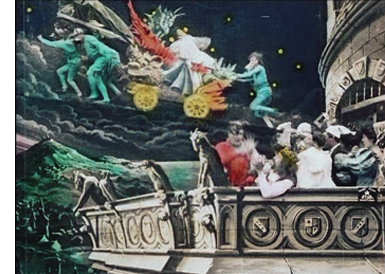 including works by Jules Verne, Jacques Offenbach, and H. G. Wells.
including works by Jules Verne, Jacques Offenbach, and H. G. Wells.
The documentary touches on issues relevant to early silent cinema in general. One of these is the frequent pirating of films, with Méliès starting an American branch of his Star Films in New York, under the direction of his brother Gaston, to help protect his intellectual property. A clip from the Segundo de Chomon version of the film, An Excursion to the Moon, is included.
At about 23 minutes in, a short overview of early movie music is given, followed by a helpful explanation of how the hand-coloring of Méliès’ films was handled by a local workshop run by women. At 30 minutes in there are several dazzling examples of hand-colored scenes (right).
After a quick summary of Méliès’ decline and death, the film moves to the restoration of the only known hand-colored copy of A Trip to the Moon, found in the film archive in Barcelona. Here the hero is Tom Burton, the Director of Technicolor Creative Services, who gives a brief indication of how computers have transformed restoration:
We have a palette of digital tools to work from that are a collection of maybe five or six of the main commercially available restoration platforms, but then we also bring into the mix all of the approaches that you would use if you were doing visual effects for a modern movie.
The comparison of visual effects with restoration is in some ways an apt one and might lead students to look upon early films in a new light.
The Girl with the Dragon Tattoo (Blu-ray/DVD/Ultraviolet set, Sony Pictures Home Entertainment)
It’s probably a good idea to supply both Blu-ray and DVD discs in one package, but including the supplements only in Blu-ray is annoying and increasingly common. That’s the way the Girl with the Dragon Tattoo discs have been handled. Teachers without access to a Blu-ray player have fewer options when trying to use supplements in teaching. It also makes it much more difficult to make frame grabs from the supplements to, say, illustrate a blog entry on useful supplements.
I decided to check out the supplements for this film because the ones for Zodiac and The Social Network were so good. I figured David Fincher was particularly concerned about his films’ bonus materials. Unfortunately this set of supplements is quite uneven. The cast and crew seem to be obsessed with the character of the heroine and with the delights of shooting in Sweden. I confess that I stopped watching some of the chapters as the talking heads went on and on about these subjects. Some of the tracks also consisted of a lot of candid behind-the-scenes footage, which is all very well, but there was little structure to this and only occasional comments to explain what was going on.
Fortunately the “Post-Production” section is very informative and interesting. “In the Cutting Room” is fairly technical but makes some fascinating points. I particularly liked the description of how Fincher eliminates reframings and unsteady shots by using the extra image space allowed by newer capture media. (Earlier digital film frames allowed no extra image area outside what would show up on the screen; as the image below indicates, the final frame can be selected from a larger picture.) This desire for a stable image in an era where the “queasi-cam” so often rules points to one distinctive trait in Fincher’s style. It indicates a willingness to actually think through the framing of each individual shot and the purpose for choosing that framing. Steven Spielberg does the same thing. Many don’t.
Editor Angus Wall talks about this advantage of the extra size of the image and how Fincher uses it to stabilize unsteady images. It’s worth quoting at length, and it demonstrates the thoughtful commentary in this particular supplement:
I’ve never seen a movie that was sort of “re-operated” to the extent that this one was. Which I think has an effect on the viewing of the movie. David is really type-A in terms of making the shots very specific. They start in a certain way, they end in a certain way. And the framing, he’s very precise in terms of his composition. He doesn’t like a lot of what you see in 99% of movies, which is very subtle moves where the operator will actually reframe according to how the actor’s moving. David doesn’t like that. Even if there were a lot of those in this film, and before, some of those takes we would have thrown out, because we just wouldn’t have been able to stabilize them to the degree that he likes it. With this, because you have this full raster, this big area around the image, you can take those images and stabilize them, really lock them down. So the movie is really locked down in terms of camera operating. More than any other movie that I can think of.
The smooth glide as the car initially approaches the country house is one example of that utter stability, used to ominous effect in that particular scene.
There’s also some interesting discussion about how the two main characters don’t meet each other until well into the film and how that affected decisions about editing. Rather than frequently intercutting between Mikael Blomkvist and Lisbeth Salander, the filmmakers decided to create longer self-contained scenes involving each, thus switching back and forth less frequently. The idea was that the exposition set forth in each scene would be too difficult to absorb if it was chopped into smaller segments. Form, style, and function, neatly explained.
Fincher also points to an interesting underlying anxiety the spectator might feel because the narrative progress gives little sense of how much action is still to come:
You don’t know where you are in the narrative. You don’t know if you’re at the beginning of the third act or … I don’t think it’s bad, because we have a five-act movie. I think that’s what’s causing everybody’s anxieties, that it doesn’t feel like, OK, here’s where we are, we’re entering the third act now. Now it feels like, fuck, this movie could go on … indefinitely. That’s the part that’s bothering me. If we told them it was going on for another forty-five minutes, they wouldn’t have a problem. It’s the indefinite part.
Since I’ve written a book claiming that classical films usually don’t have three acts, I was intrigued by this statement. (See also my earlier blog entry here and David’s essay here.) I posit instead that classical films typically create acts that run about 25 to 30 minutes, and that the film’s length determines how many acts it has. Four acts is the most common throughout Hollywood’s history, but a 158-minute film would be likely to have five acts. (Has David Fincher read my book?!) His point about the audience feeling a bit lost in an unconventional narrative structure is a rare instance of a director talking about form in such an abstract way, and it seems quite valid for The Girl with the Dragon Tattoo.
It’s also rare to get a supplement on ADR (automated [or additional] dialogue replacement), but there’s a six-minute one in the “Post-Production” section. This consists of a behind-the-scenes session with Rooney Mara supplying not just dialogue but breathing, grunts, and other noises. It’s clearly a real session, not a staged one, though the actress does seem a bit self-conscious with the documentarian’s camera turned on her. Fincher’s and Mara’s banter between takes gives a sense of what I suspect really goes on during this phase of production.
There’s a brief supplement called “Main Titles,” which deals with the form and inspiration for the CGI under the titles. Fincher wanted to tell the story of the whole trilogy in two and a half minutes, “and it has to be spectacular.” Apart from the discussion of form, there’s a good look at unrendered CGI footage compared to the finished images.
Finally, an eight-minute “Visual Effects Montage” displays a variety of special effects in a clever way. There is a section at the beginning where we are shown the image without added effects, then the same image with the areas to be altered highlighted in various superimposed colors, and finally the finished images with the effects added. This is particularly good for showing the sorts of mundane effects that are used to enhance shots unnoticeably, adding cars’ headlight beams, reflections in glass, falling snow, and the like. There is a shot with a section of a building on location blotted out with a greenscreen and the final shot showing the use of alterations in the building:
Obviously here the fog was also added with CGI.
This montage goes very quickly. If you’re using it in a class, best to prepare ahead and be ready to pause and point out what’s going on in the many short shots used in the demonstrations.
The second half of the effects montage moves to splashier scenes of the type the public associates with “special effects”: wire-frame vehicles for a chase (see image at the top of this section), head-replacement to add Mara’s head to her stunt-double’s body, and explosions.
Don’t bother with the “Stockholm Syndrome” section. Basically all we learn is that when a scene is shot on location, sheep can unexpectedly wander in and interfere.
The Adventures of Tintin (Blu-ray/DVD/Digital Copy combo, Paramount Pictures)
Again, the supplements for this release are available only in Blu-ray.
Steven Spielberg and Peter Jackson decided some years ago to collaborate on what was announced to be a three-film series adapted from Hergé’s Tintin comic books. The notion was that each of them would direct one film, with an as-yet-unspecified director doing the third. Spielberg’s initiatory film did not do as well at the domestic box-office as had been hoped, though it fared better in Europe and other non-North American markets, where the comics are highly popular. Jackson has announced that after he finishes both parts of The Hobbit, he will launch into the next Tintin film. (At least, that’s what he said originally. After yesterday’s announcement that there will be three Hobbit films, his start on the Tintin film will presumably be delayed.)
The supplements form a narrative of the film’s making, bookended by “Toasting Tintin” and “Toasting Tintin Part 2,” brief episodes set at the launch and wrap parties. The tale is pleasant and generally worth watching, though they are far from as entertaining and informative as the supplements that Michael Pellerin produced and directed for Jackson’s The Lord of the Rings and King Kong DVD sets. But this is Spielberg’s show, since he did the first film and indeed originated the project. At first he envisioned the film as live-action, with the dog Snowy the only major CGI character. Spielberg asked Jackson’s effects house Weta Digital to do some tests animating Snowy. To his (apparent) surprise, Jackson himself, as a fan of the comics since childhood, played Captain Haddock in the test. That fact was well known to fans, and the inclusion of the test footage (above) is no doubt a crowd-pleaser.
The decision to use cutting-edge performance-capture techniques led to the film being entirely animated.
“The World of Tintin” gives background on Hergé and deals briefly with the screenwriting process. This leads into “The Who’s Who of Tintin,” dealing with characters and acting, with some good material on performance capture near the end. The next section, “Tintin: Conceptual Design” has good material on the visual style of the characters and near the end includes some pre-viz material.
The outstanding supplement, however, is “Tintin: In the Volume,” nearly 18 minutes of footage concerning performance capture. Spielberg’s role as director was primarily concentrated into a remarkably short 31-day shoot with the actors. This was done in a state-of-the-art performance-capture facility called “The Volume” and located at Giant Studios. The Volume is a large space with about 160 cameras built into the ceiling and pointing down into the performance space. These capture the space from multiple angles. Additional cameras on the stage level follow the actors’ movements, which are inserted into the space. Moreover, hand-held monitors similar to portable gaming devices allow the filmmakers to see simple versions of the settings and the partially rendered characters while pointing the device at the actors in their performance-capture rigs.
There are also larger monitors that show the actors their own performances translated into the characters (top of entry). Whatever one thinks of the look of contemporary animation of this type, the technology has evolved to a remarkable level, and this supplement provides an excellent explanation of the practicalities of performance capture. We see the motion-capture suits being put on and the dots painted onto the actors’ skin. There is also information on how the set elements and props need to be transparent so that the cameras can capture the dots on the actors’ faces and costumes through them. The image at the bottom shows Jamie Bell as Tintin looking at a mock-up of the model ship. It’s made of little metal rods and rendered into a ship on the monitors.
“Snowy: From Beginning to End” is less cutesy than it sounds. It discussed the digital tool developed for modeling the dog’s fur. There’s also good stuff on how several dogs were recorded to provide different-sounding barks depending on the type of action in a scene.
The biggest tasks on the film came after the performance capture and editing. Weta Digital spent two years creating the final images. “Animating Tintin” is an excellent eleven-minute account of that process.
The sections “Tintin: The Score” and “Collecting Tintin” (on Weta Workshop’s designs for the collectible figures) are rather thin and could be skipped unless a teacher wants to show the whole set of supplements as a single “making-of” documentary.
It’s become apparent that many of the best supplements on Blu-ray and/or DVD releases are devoted to special effects, especially performance capture. The Adventures of Tintin does genuinely involve innovations in this technology, and the “In the Volume” chapter is very informative. Supplements are getting repetitive, though, and I would like to see the producers of such documentaries pay more attention to techniques and choices in other areas. Comparing final cuts of scenes with earlier cuts, or showing story conferences where real debates about scripts occur (as was done in the first Pirates of the Caribbean film’s supplements), or displaying how decisions about digital-intermediate grading are made–a bit of imagination could spice up the offerings. That and a realization that film fans are interested in just about any aspect of production (or distribution, for that matter). Supplements risk falling into conventional patterns, and that won’t make them the appealing bonus material that they used to be.
While I was gearing up to write this entry, we received Mark Parker and Deborah Parker’s book, The DVD and the Study of Film: The Attainable Text (Palgrave, 2011). Based on a great deal of research, including many interviews, the authors include a summary history of DVDs and supplements; there is a detailed chapter on The Criterion Collection, interviews with directors and scholars who have recorded commentary tracks, and a case study of Atom Egoyan.













